Table of Contents
✔ The wall, fence, or enclosing structure constructed to separate two parcels of lands, properties, or borders is a boundary wall.
✔ Local regulations may guide the construction of boundary walls, like specific height limits, setbacks from property lines, and other criteria. So, before the commencement of the construction, local regulations should be studied well.
1. Importance of Boundary Wall
The importance of boundary walls are:
a. To provide safety and security to the structure.
b. To reduce queries and fights between landlords.
c. To separate the boundary between the countries.
d. To separate two parcels of lands or properties.
2. Types of Boundary Wall
a. Brick Boundary Wall
The boundary wall constructed using bricks as the key material is called a brick boundary wall.
Construction of Brick Boundary Wall
✔ To initiate the construction process, the designated area is excavated to a depth of 4′-5′, and the soil is uniformly compacted at the bottom of the excavation.
✔ A brick flat soling is then placed at the lowest point, followed by the application of PCC.
✔ Above the PCC, a trapezoidal footing is constructed, and a tie beam with a thickness of 10″ is built.
✔ Once the tie beam is in place, a column is erected to support the boundary wall and prevent structural failure.
✔ To enhance the security of the structure, brickwork is performed over the tie beam.
✔ Finally, coping is added above the brickwork to complete the construction process.
A Brick Boundary Wall is widely used in residential, commercial, and industrial properties to separate two parcels of lands, properties, or borders. Some of the information regarding the brick boundary wall is given below:
| Aspect | Description |
|---|---|
| Materials | Clay bricks, concrete bricks, or masonry bricks with mortar bonding. |
| Design and Aesthetics | Classic appearance with various style options. |
| Height and Width | Heights: 1.5 to 2.5 meters (5-8 feet), Widths: 20-30 cm (8-12 inches). |
| Privacy and Security | High privacy and security; suitable for residential and commercial use. |
| Durability | Weather-resistant and low maintenance with occasional repointing. |
| Cost | Variable cost based on materials, height, and design complexity. |
| Foundations | Require strong foundations; depth varies by wall height and soil conditions. |
| Local Regulations | Check local building codes and regulations for compliance. |
| Maintenance | Periodic inspections and maintenance for mortar and cracks. |
| Customization | It is highly customizable in brick colors, patterns, and textures. |
Standard Height of Brick Boundary Wall
The standard height and width of brick boundary wall in different nations is provided below:
| Region | Typical Height | Typical Width |
|---|---|---|
| Asia | 1.5 – 2.5 meters (5 – 8 feet) | 20 – 30 centimeters (8 – 12 inches) |
| Europe | 1.0 – 2.0 meters (3 – 6.5 feet) | 25 – 40 centimeters (10 – 16 inches) |
| USA | 0.9 – 1.8 meters (3 – 6 feet) | 20 – 30 centimeters (8 – 12 inches) |
| Australia | 1.2 – 2.4 meters (4 – 8 feet) | 20 – 30 centimeters (8 – 12 inches) |
| India | 1.5 – 2.5 meters (5 – 8 feet) | 20 – 30 centimeters (8 – 12 inches) |
| UK | 1.0 – 2.0 meters (3 – 6.5 feet) | 25 – 40 centimeters (10 – 16 inches) |
| Canada | 1.0 – 2.0 meters (3 – 6.5 feet) | 25 – 40 centimeters (10 – 16 inches) |
| Philippines | 1.5 – 2.5 meters (5 – 8 feet) | 20 – 30 centimeters (8 – 12 inches) |
Different Brick Boundary Wall Designs
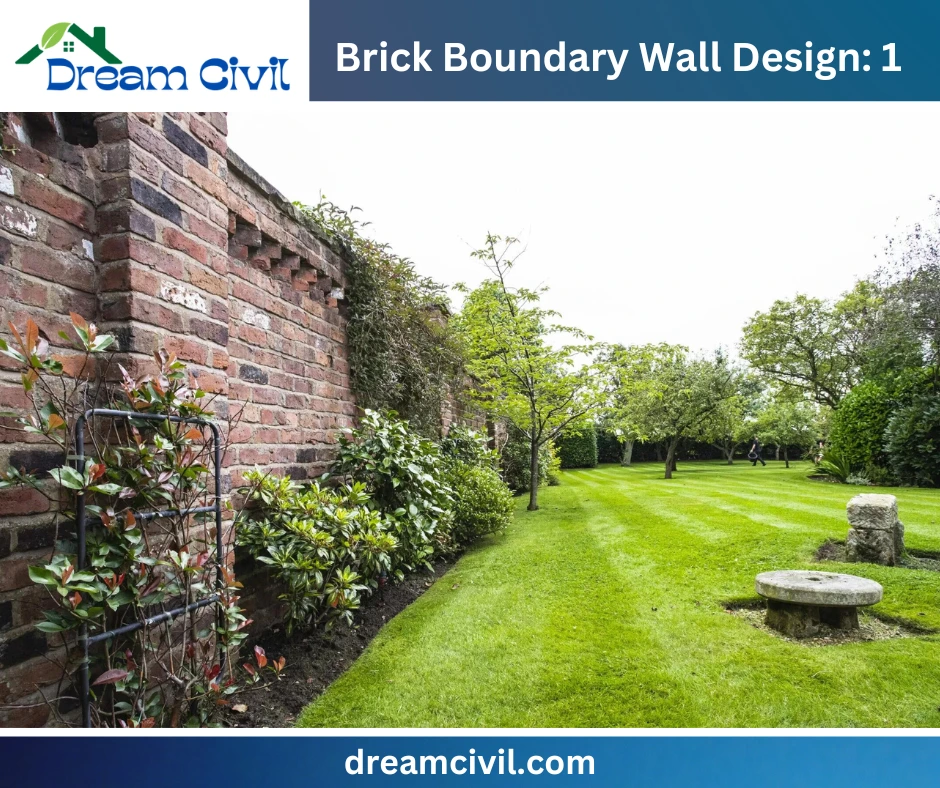
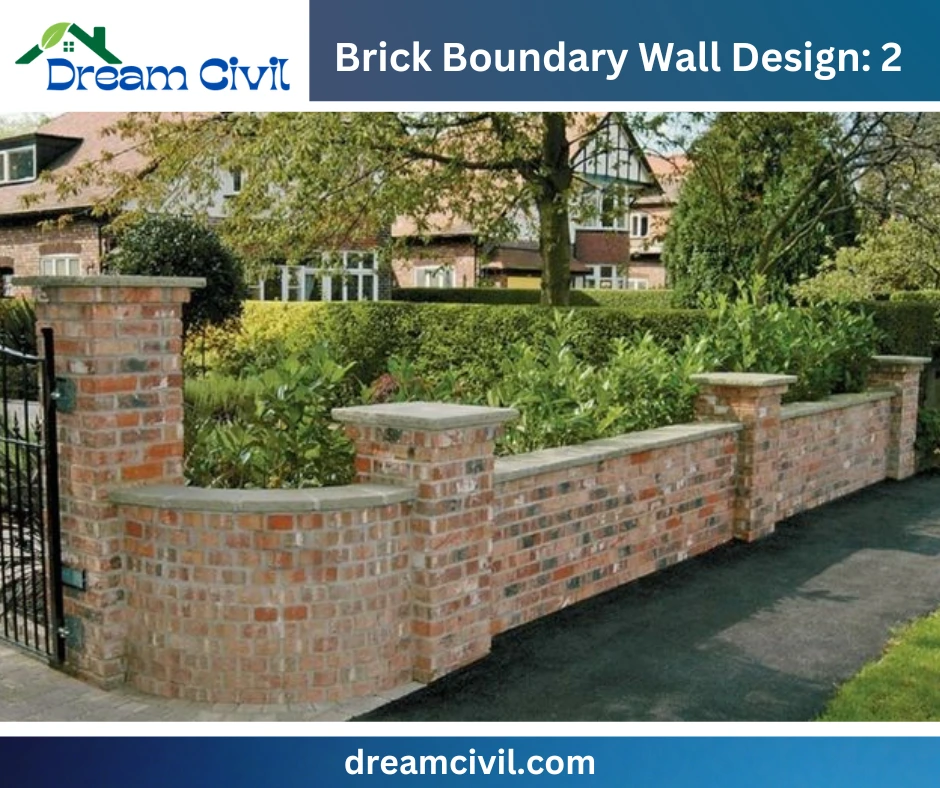
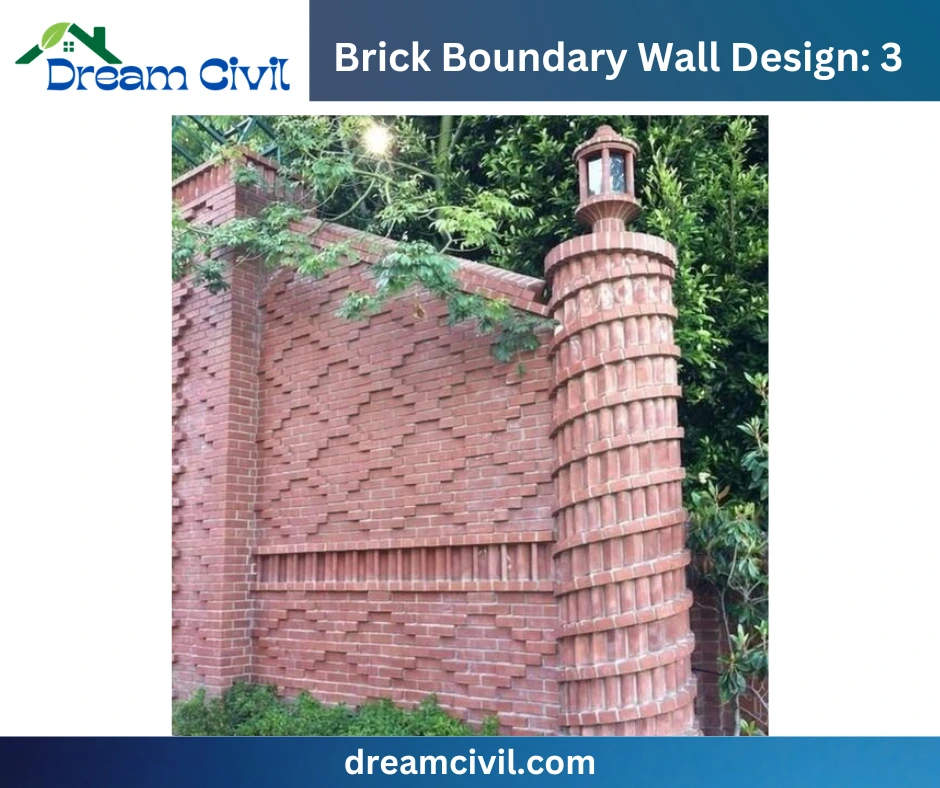
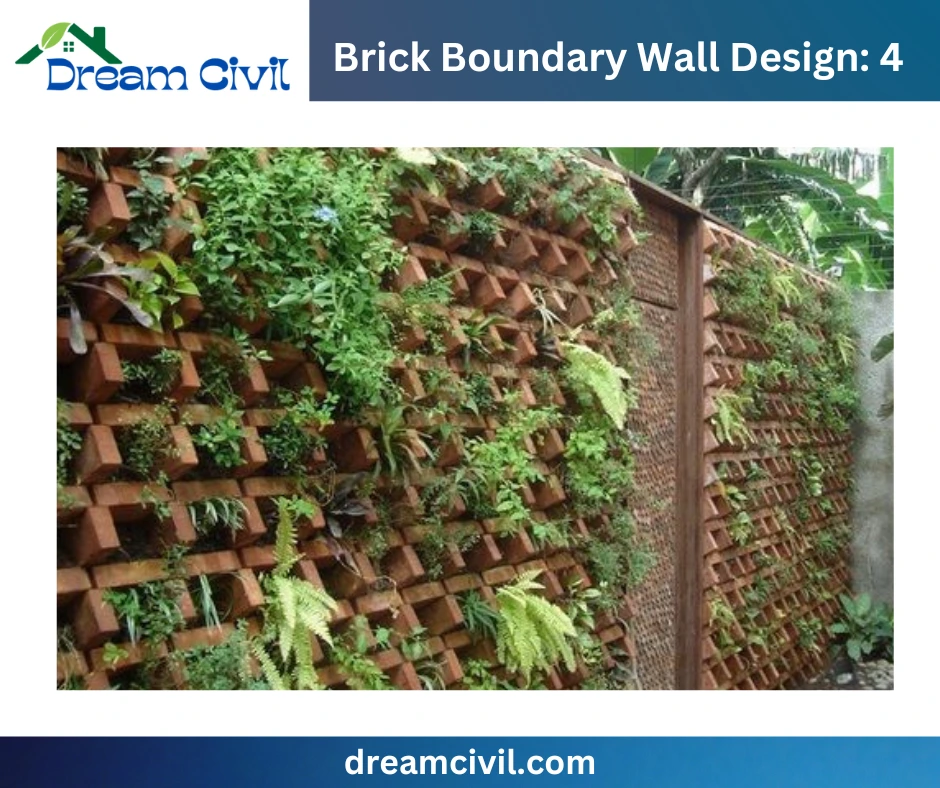
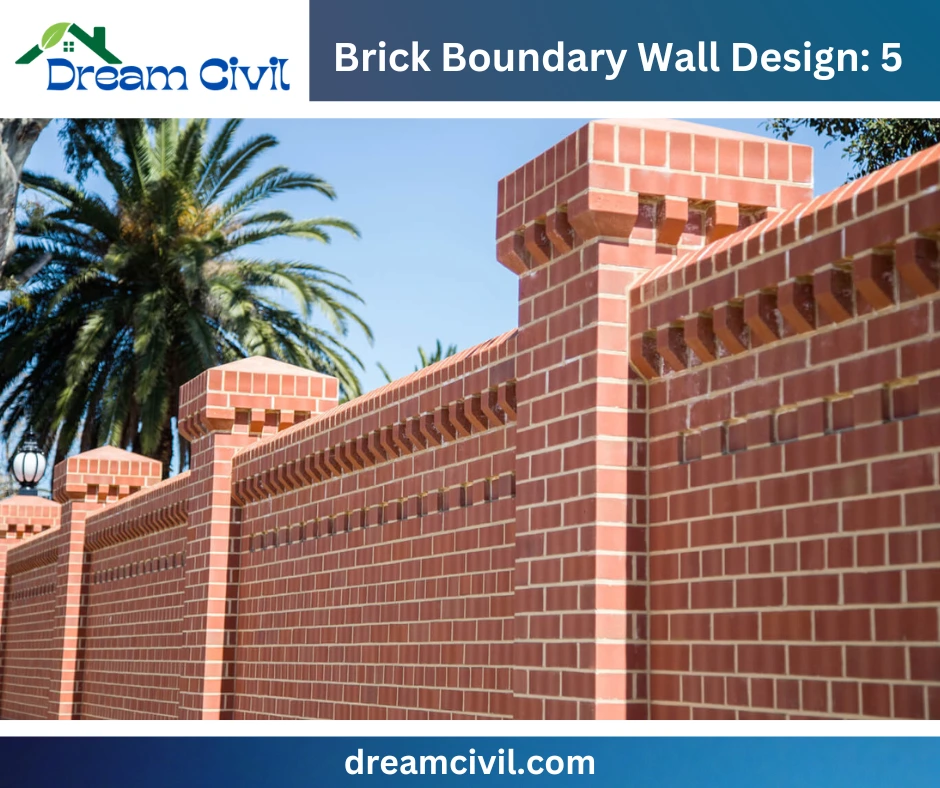
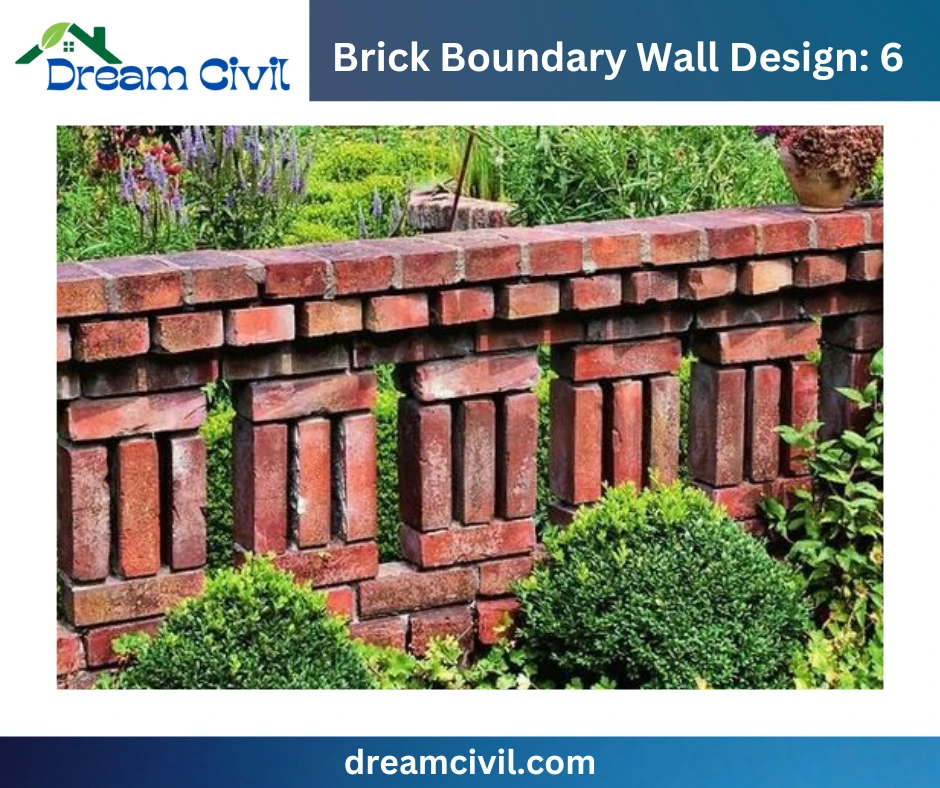
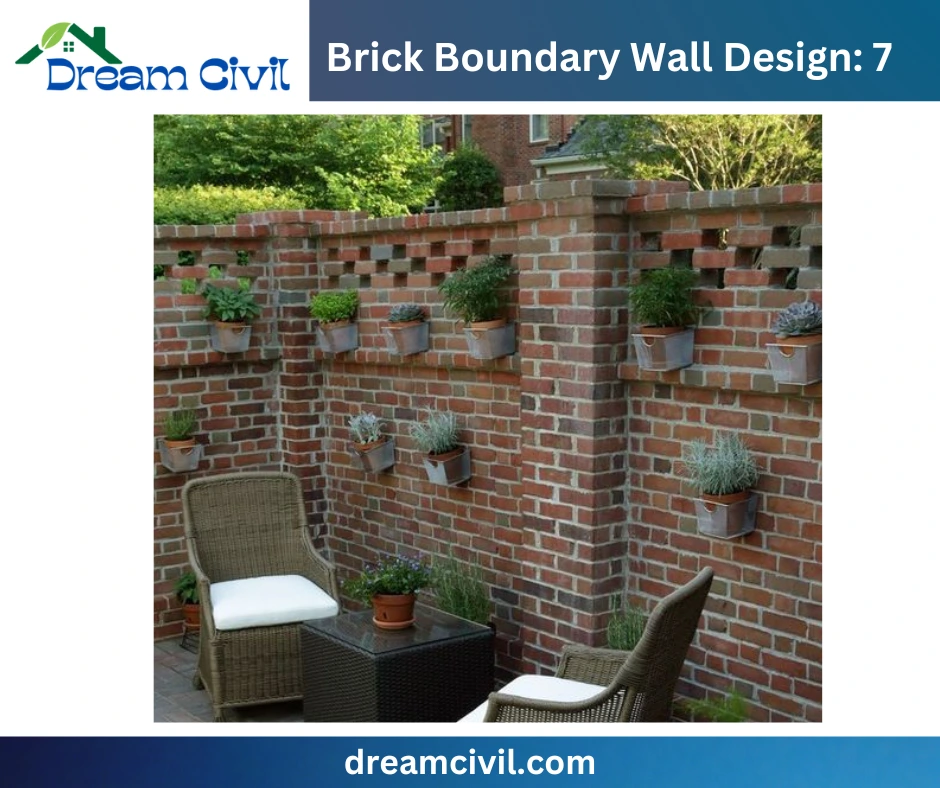
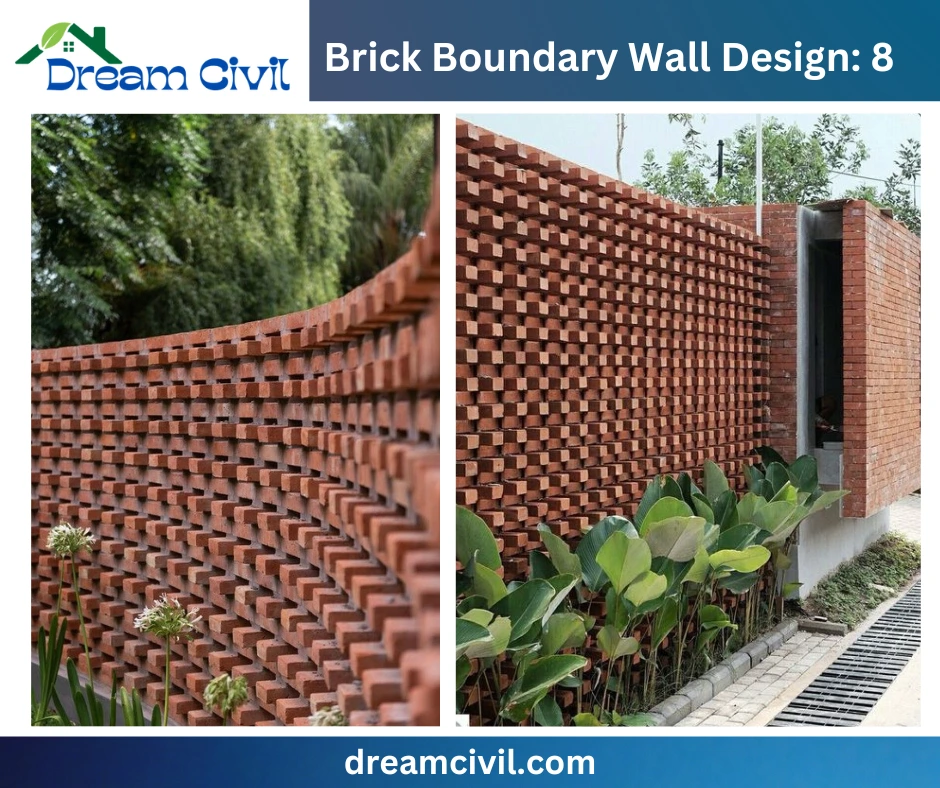
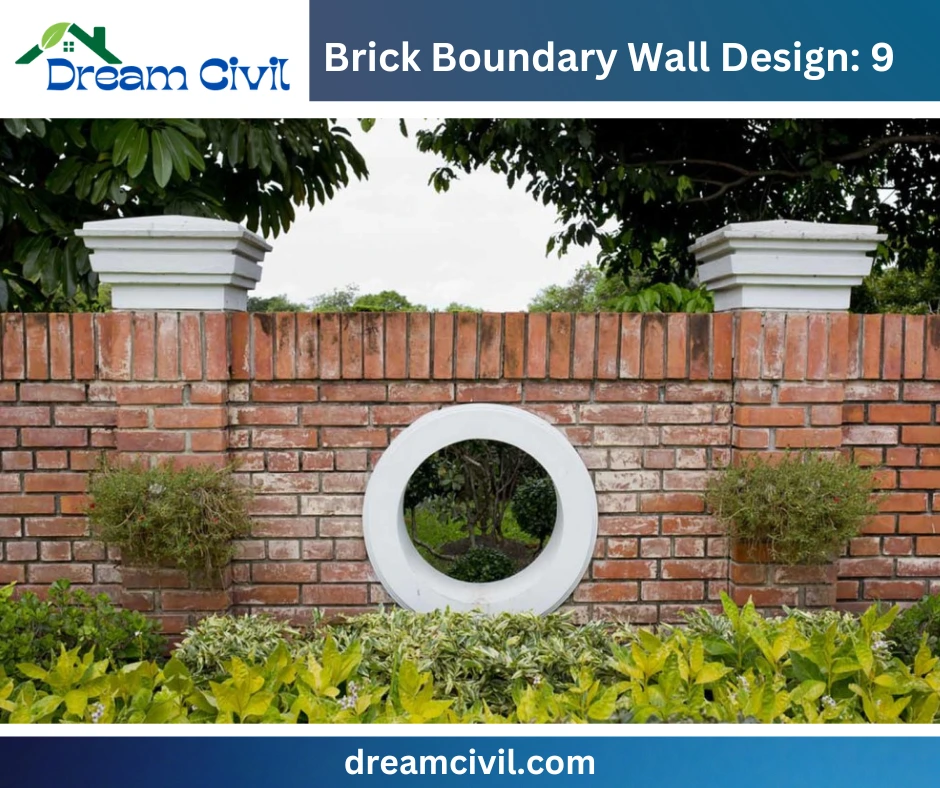
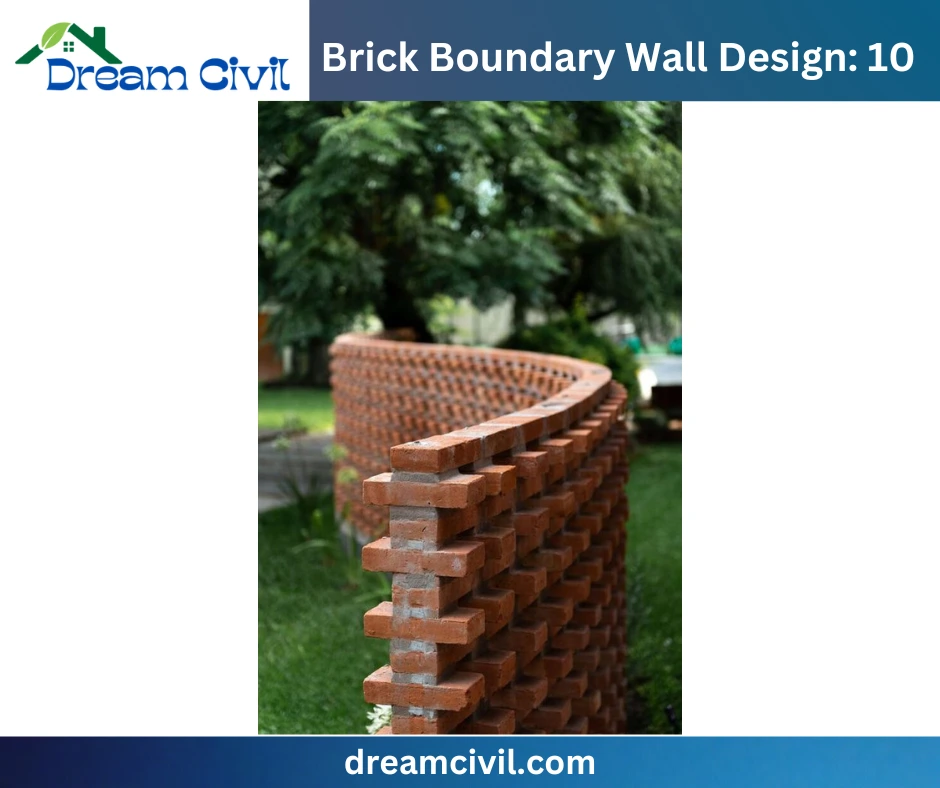
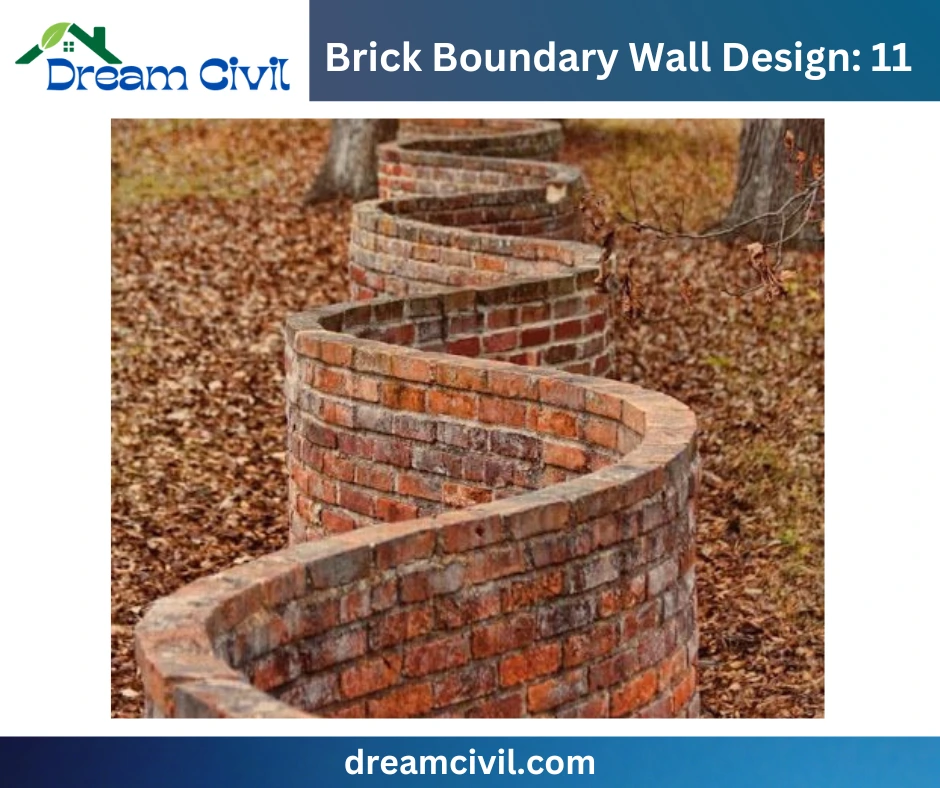
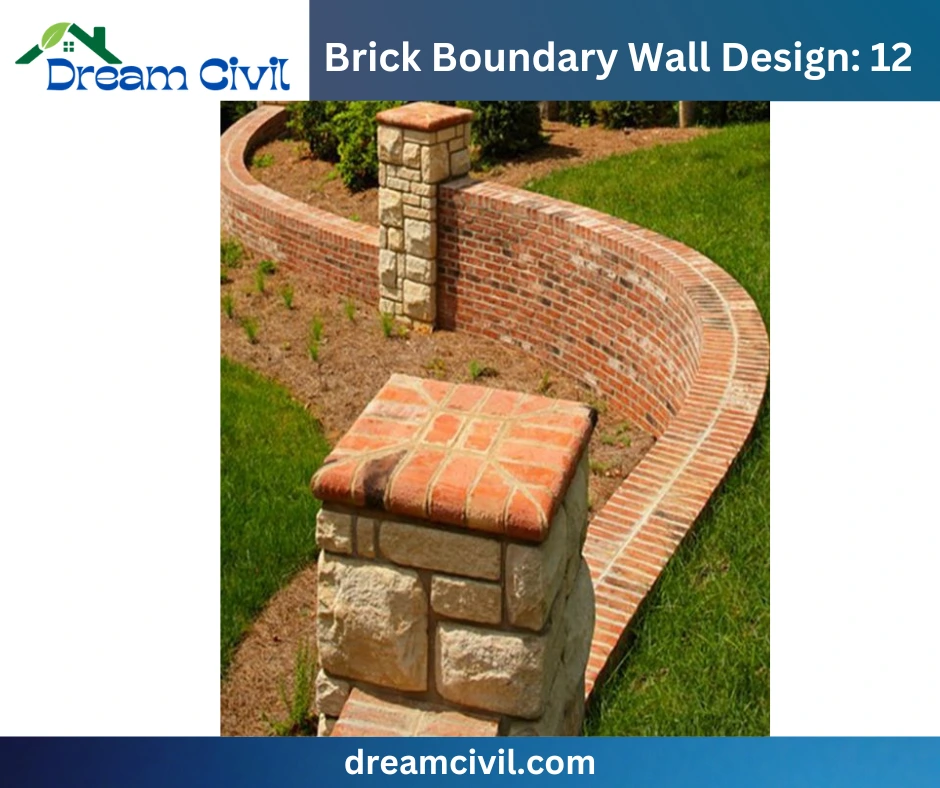
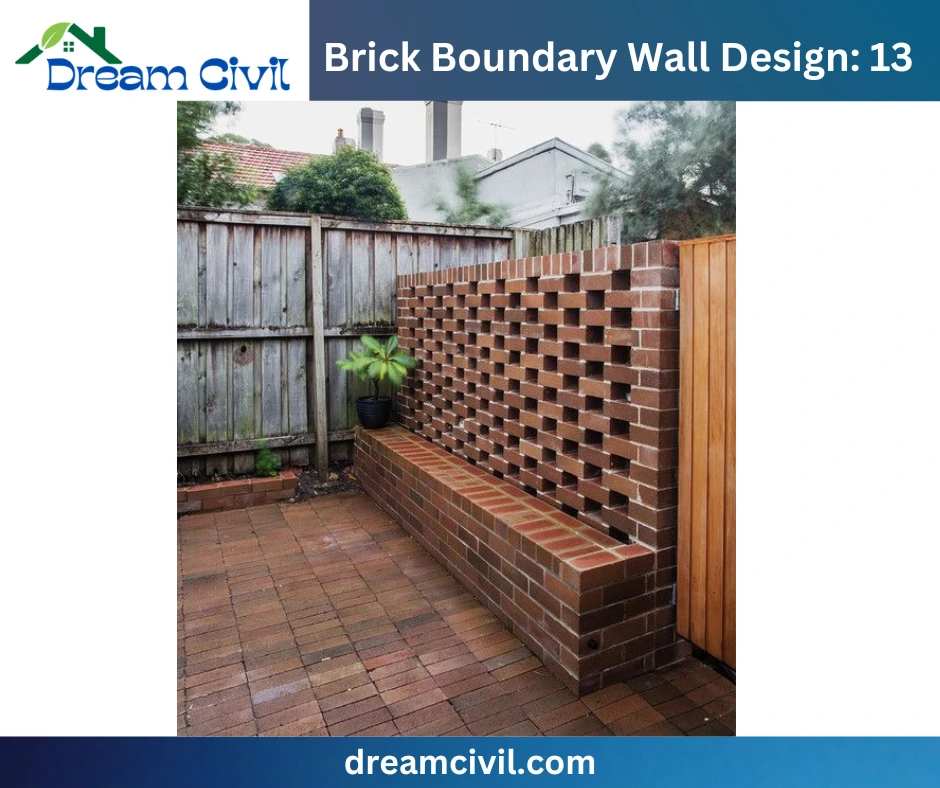
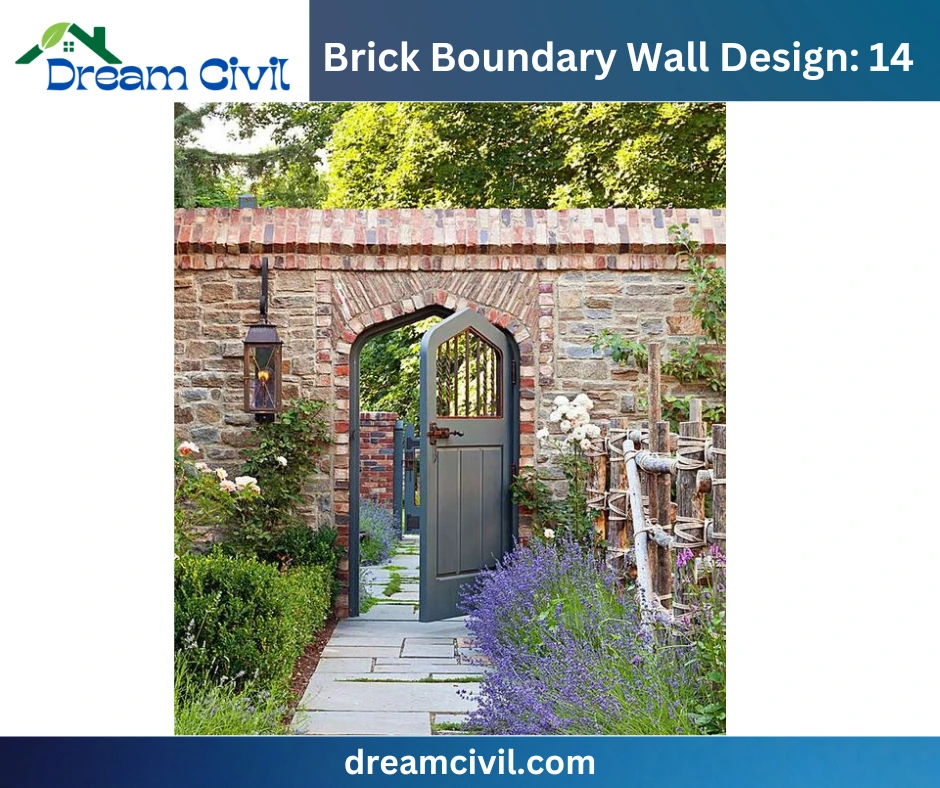
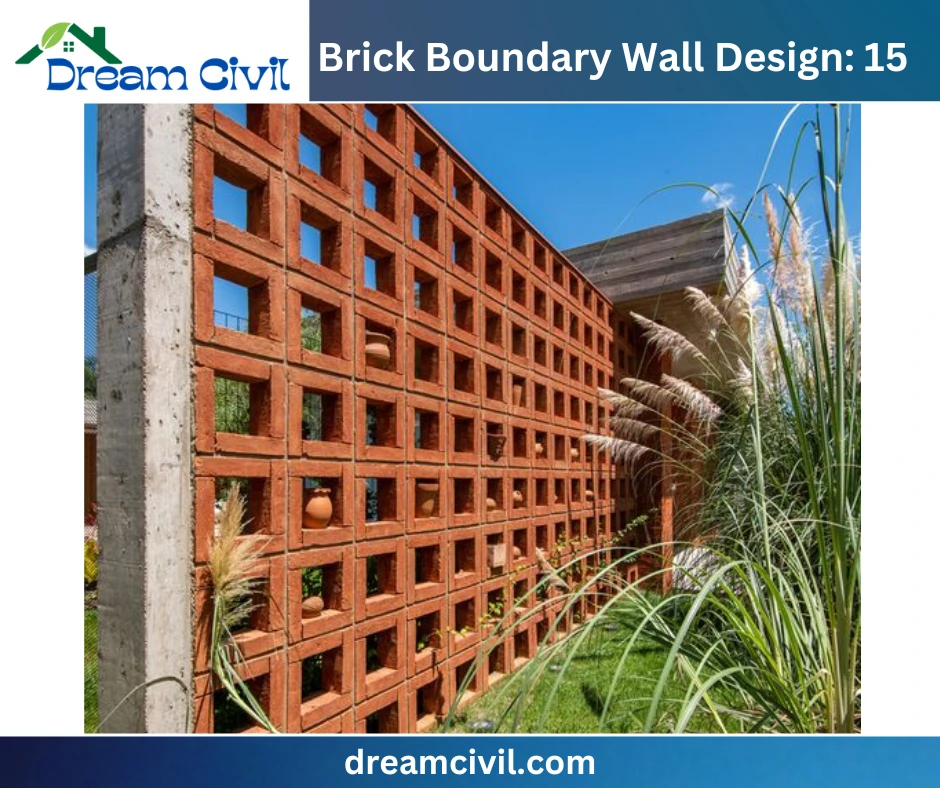
b. Stone Boundary Wall
The boundary wall constructed using stones as the key material is called a stone boundary wall.
Some of the information regarding the brick boundary wall is given below:
| Aspect | Description |
|---|---|
| Materials | Natural stone blocks with mortar bonding. |
| Design & Style | Rustic appearance with various stone types. |
| Height & Width | Heights: 1.5-2.5 meters, Widths: 30-45 cm. |
| Privacy & Security | Offers privacy and security for different settings. |
| Durability | Highly weather-resistant; low maintenance. |
| Cost | Variable based on stone type, height, and design. |
| Foundations | Requires strong foundations; depth varies. |
| Regulations | Comply with local building codes and rules. |
| Maintenance | Periodic inspections and mortar upkeep. |
| Customization | Limited customization compared to bricks. |
Standard Height of Stone Boundary Wall
The standard height and width of stone boundary wall in different nations is provided below:
| Region | Typical Height | Typical Width |
|---|---|---|
| Asia | 1.5 – 2.5 meters (5 – 8 feet) | 30 – 45 centimeters (12 – 18 inches) |
| Europe | 1.0 – 2.0 meters (3 – 6.5 feet) | 30 – 45 centimeters (12 – 18 inches) |
| USA | 0.9 – 1.8 meters (3 – 6 feet) | 30 – 45 centimeters (12 – 18 inches) |
| Australia | 1.2 – 2.4 meters (4 – 8 feet) | 30 – 45 centimeters (12 – 18 inches) |
| India | 1.5 – 2.5 meters (5 – 8 feet) | 30 – 45 centimeters (12 – 18 inches) |
| UK | 1.0 – 2.0 meters (3 – 6.5 feet) | 30 – 45 centimeters (12 – 18 inches) |
| Canada | 1.0 – 2.0 meters (3 – 6.5 feet) | 30 – 45 centimeters (12 – 18 inches) |
| Philippines | 1.5 – 2.5 meters (5 – 8 feet) | 30 – 45 centimeters (12 – 18 inches) |
Stunning Designs of Stone Boundary Wall
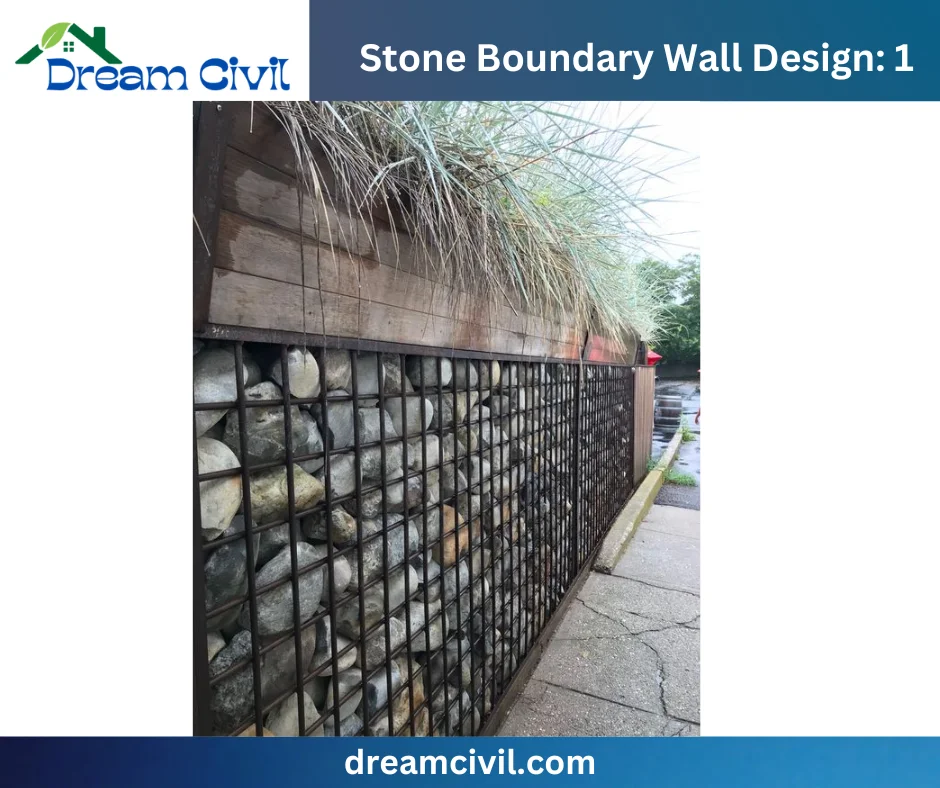
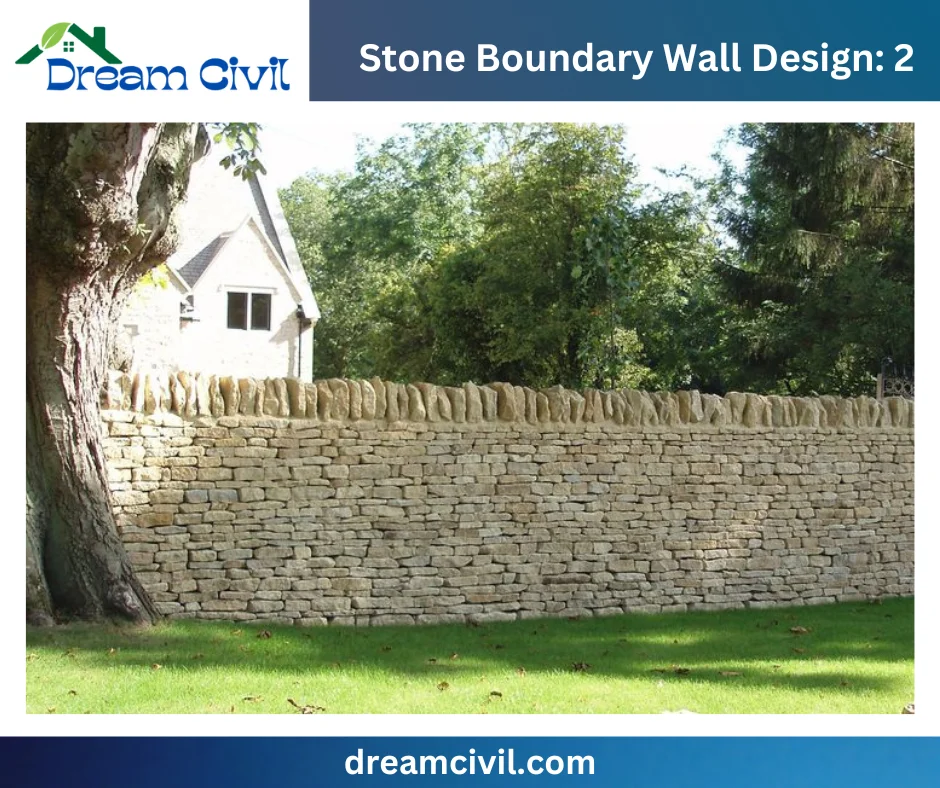
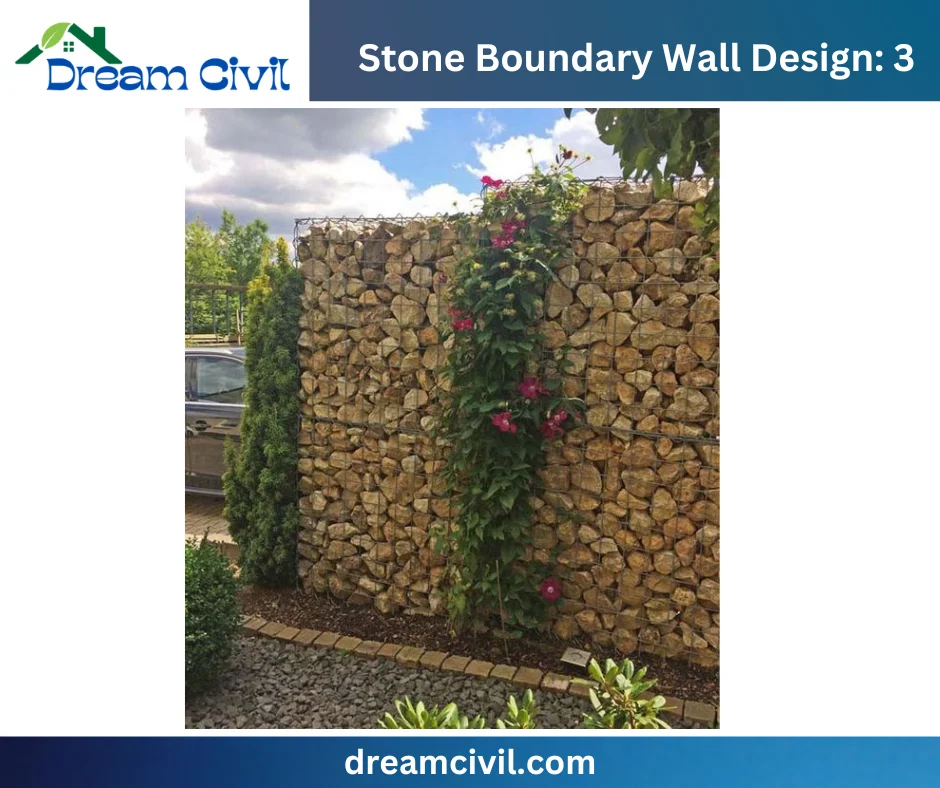
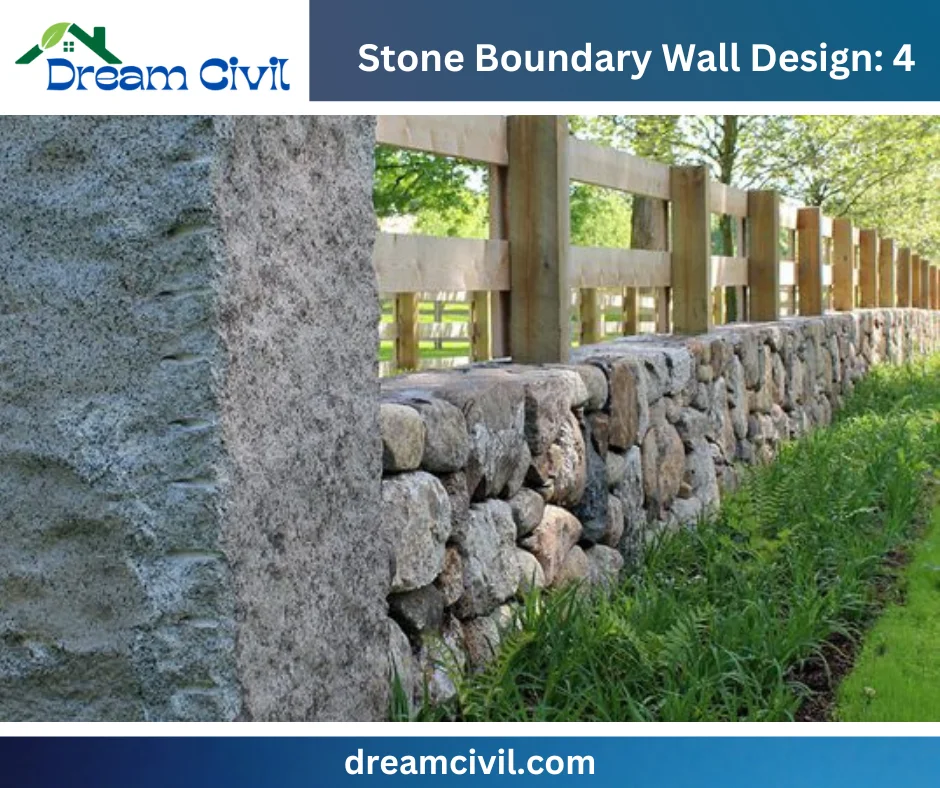
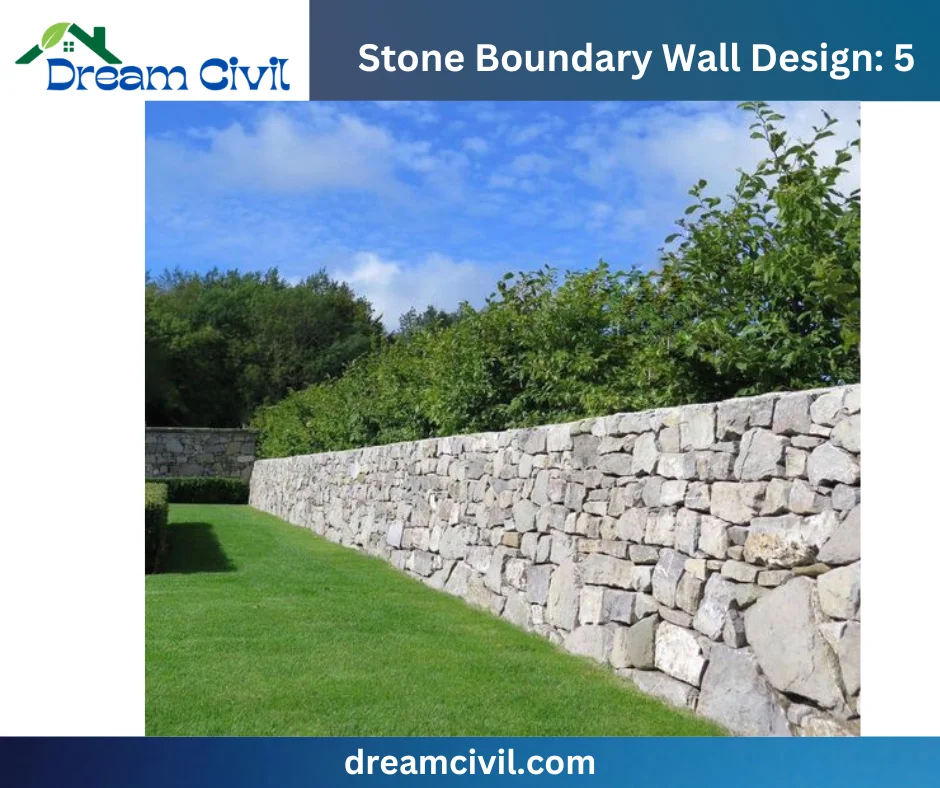
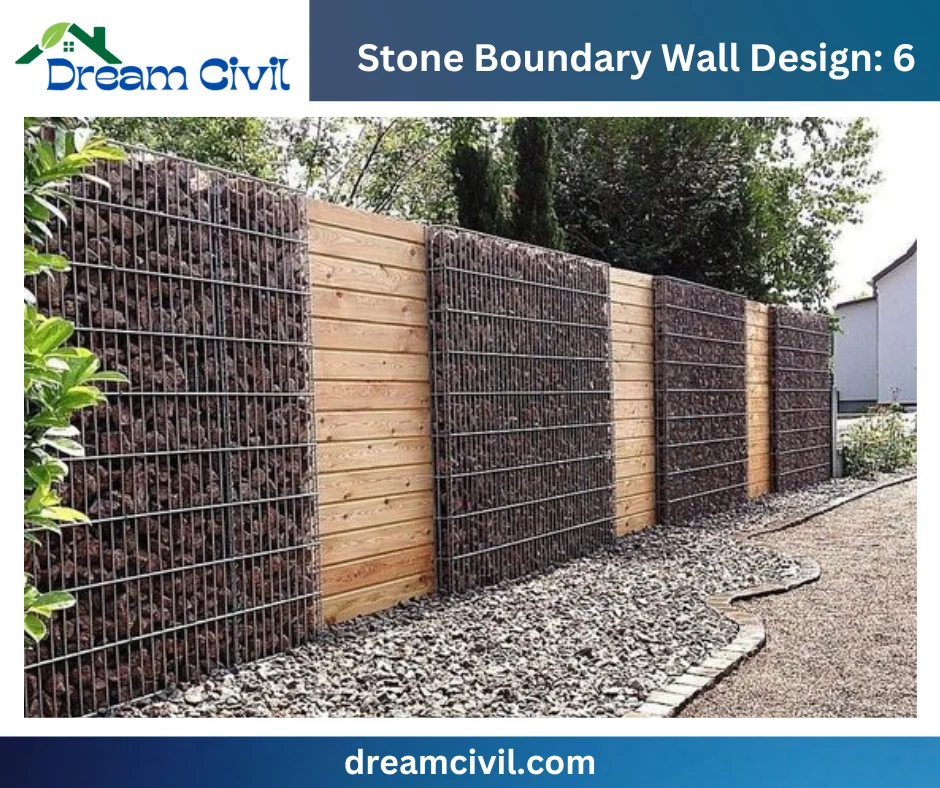
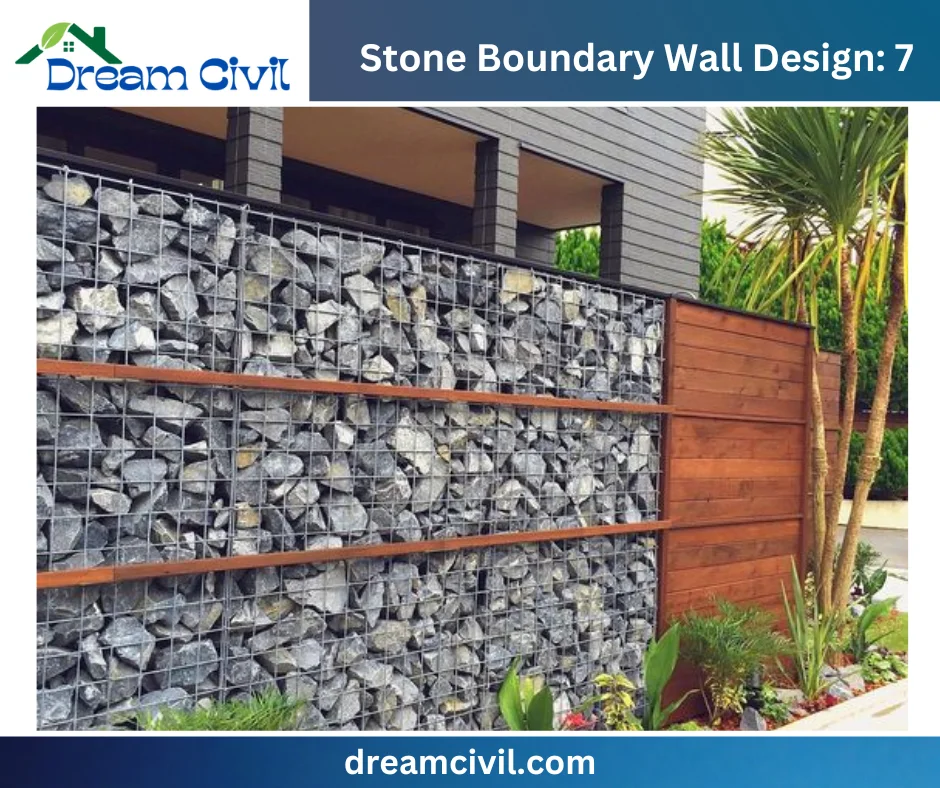
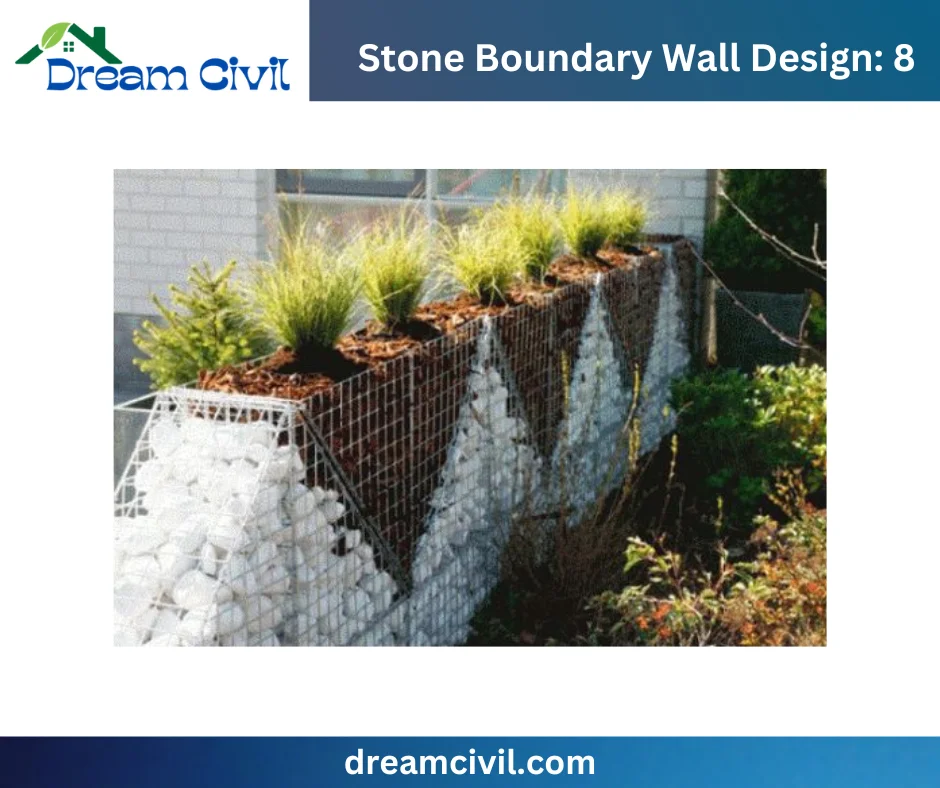
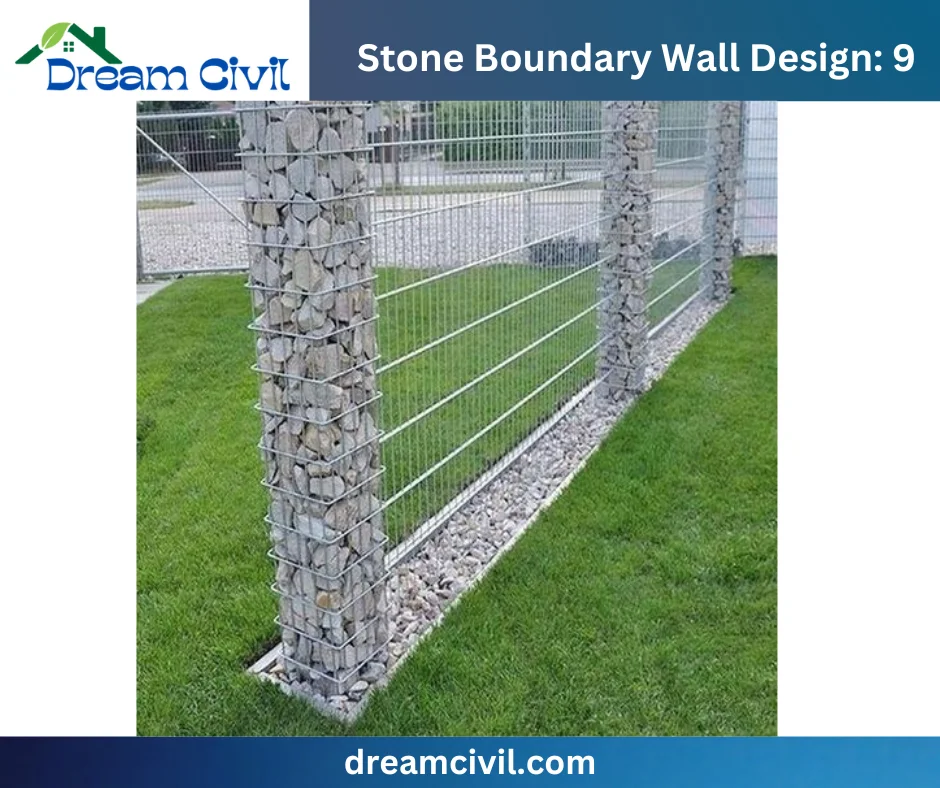
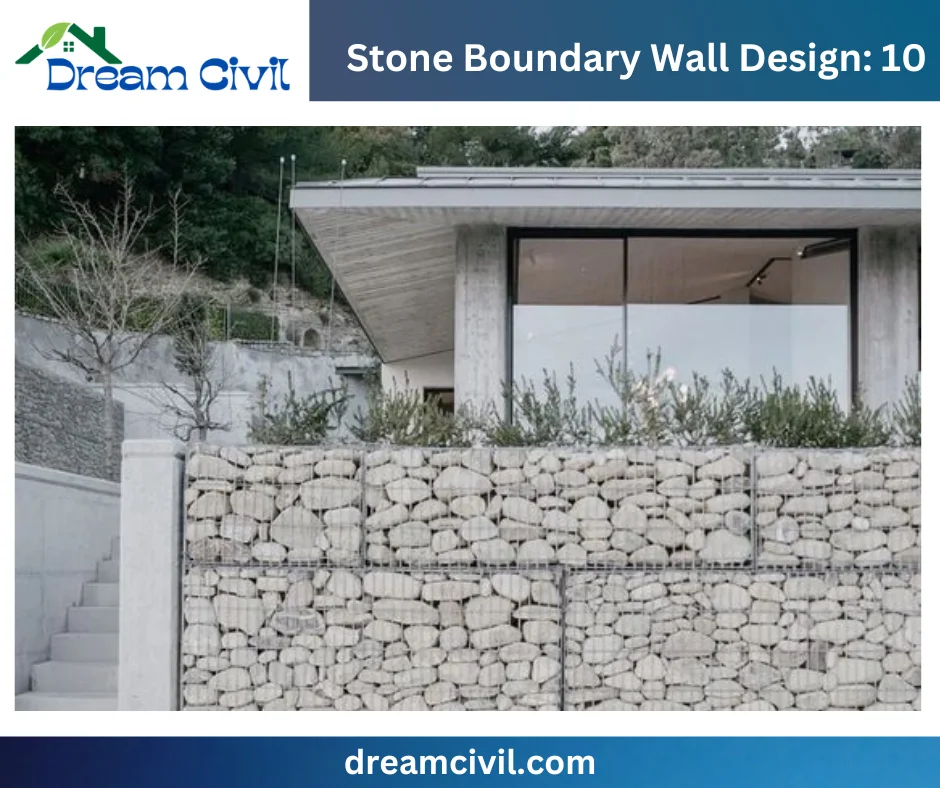
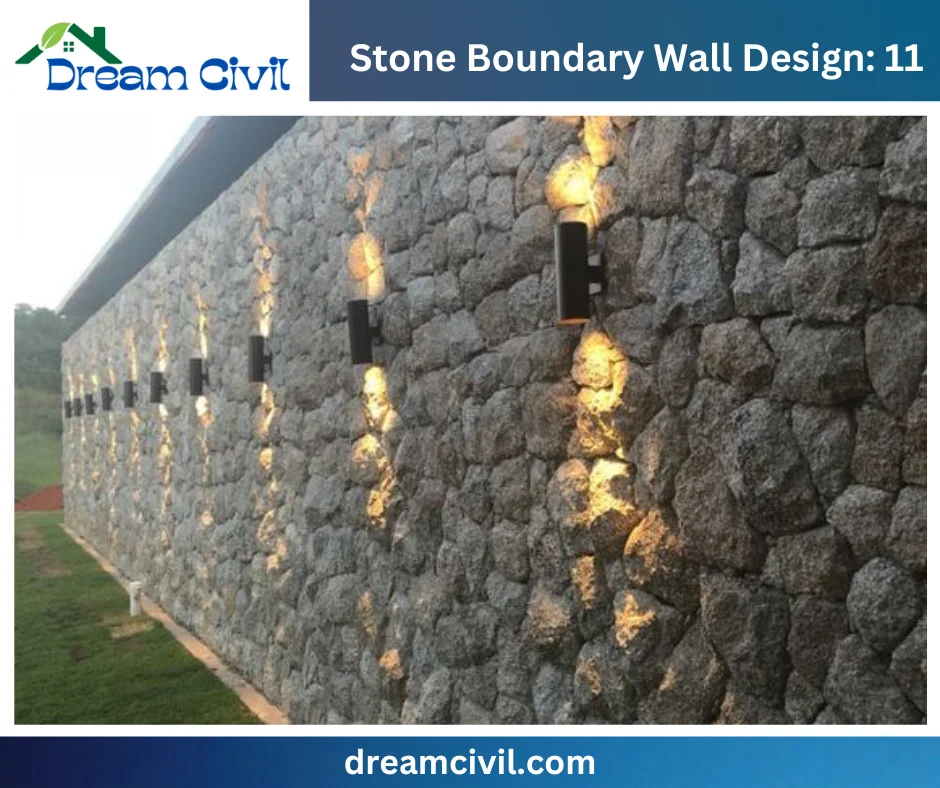
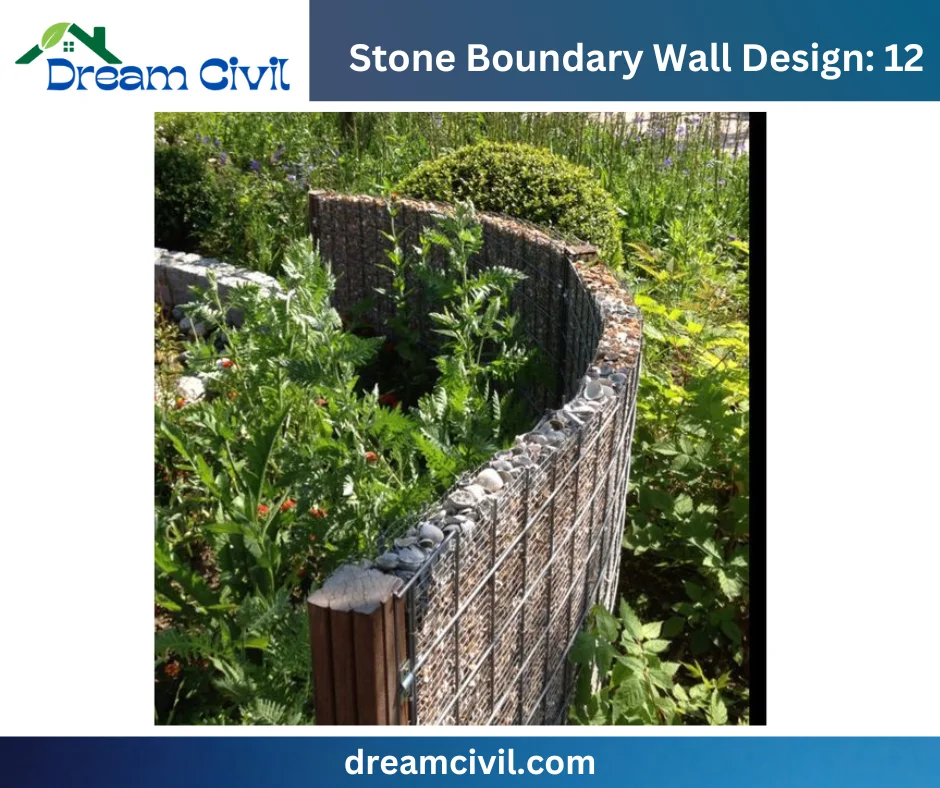
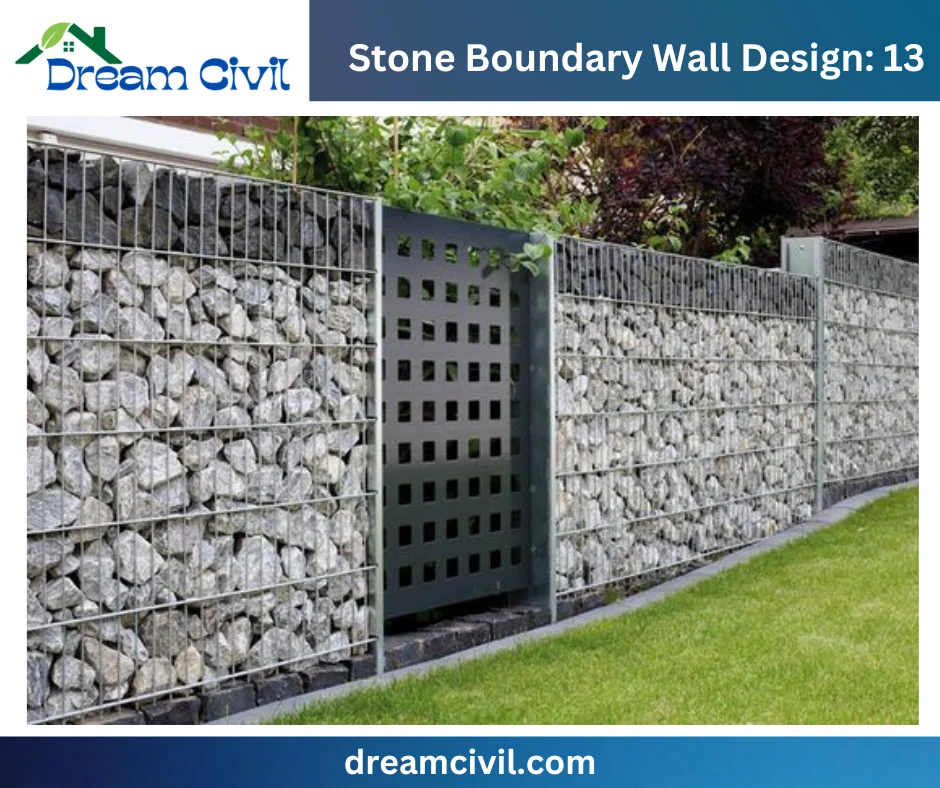

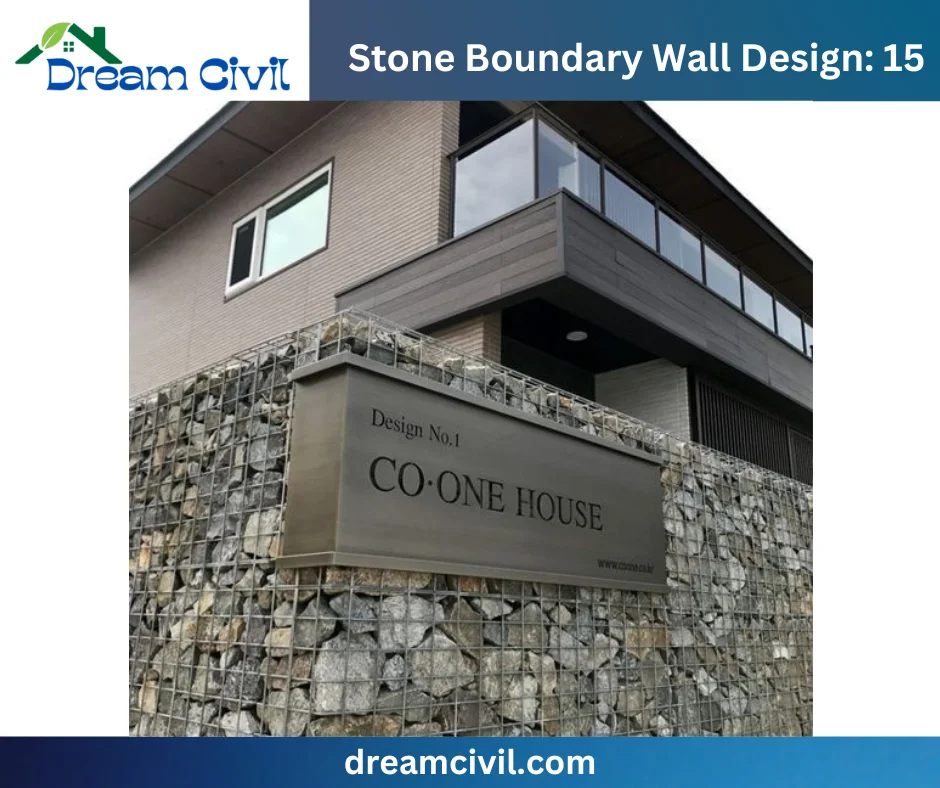
c. Wooden Boundary Wall
The boundary wall constructed using wood as the key material is called a wooden boundary wall.
Some of the information regarding the wooden boundary wall is given below:
| Aspect | Description |
|---|---|
| Materials | Wooden planks or logs, typically treated for durability. |
| Design & Style | Natural and rustic appearance; various wood types available. |
| Height & Width | Heights: 1.0-2.0 meters, Widths: 10-20 cm. |
| Privacy & Security | It provides privacy but may be less secure than other materials. |
| Durability | Subject to weathering and requires regular maintenance. |
| Cost | Variable based on wood type, height, and design. |
| Foundations | Requires sturdy post or beam foundations. |
| Regulations | Must adhere to local building codes and regulations. |
| Maintenance | Frequent maintenance due to wood’s susceptibility to decay. |
| Customization | Offers flexibility in design and finish options. |
Standard Height of Wooden Boundary Wall
The standard height and width of wooden boundary wall in different nations is provided below:
| Region | Typical Height | Typical Width |
|---|---|---|
| Asia | 1.0 – 2.0 meters (3 – 6.5 feet) | 10 – 20 centimeters (4 – 8 inches) |
| Europe | 1.0 – 2.0 meters (3 – 6.5 feet) | 10 – 20 centimeters (4 – 8 inches) |
| USA | 0.9 – 1.8 meters (3 – 6 feet) | 10 – 20 centimeters (4 – 8 inches) |
| Australia | 1.0 – 2.0 meters (3 – 6.5 feet) | 10 – 20 centimeters (4 – 8 inches) |
| India | 1.0 – 2.0 meters (3 – 6.5 feet) | 10 – 20 centimeters (4 – 8 inches) |
| UK | 1.0 – 2.0 meters (3 – 6.5 feet) | 10 – 20 centimeters (4 – 8 inches) |
| Canada | 1.0 – 2.0 meters (3 – 6.5 feet) | 10 – 20 centimeters (4 – 8 inches) |
| Philippines | 1.0 – 2.0 meters (3 – 6.5 feet) | 10 – 20 centimeters (4 – 8 inches) |
Stunning Designs of Wooden Boundary Wall



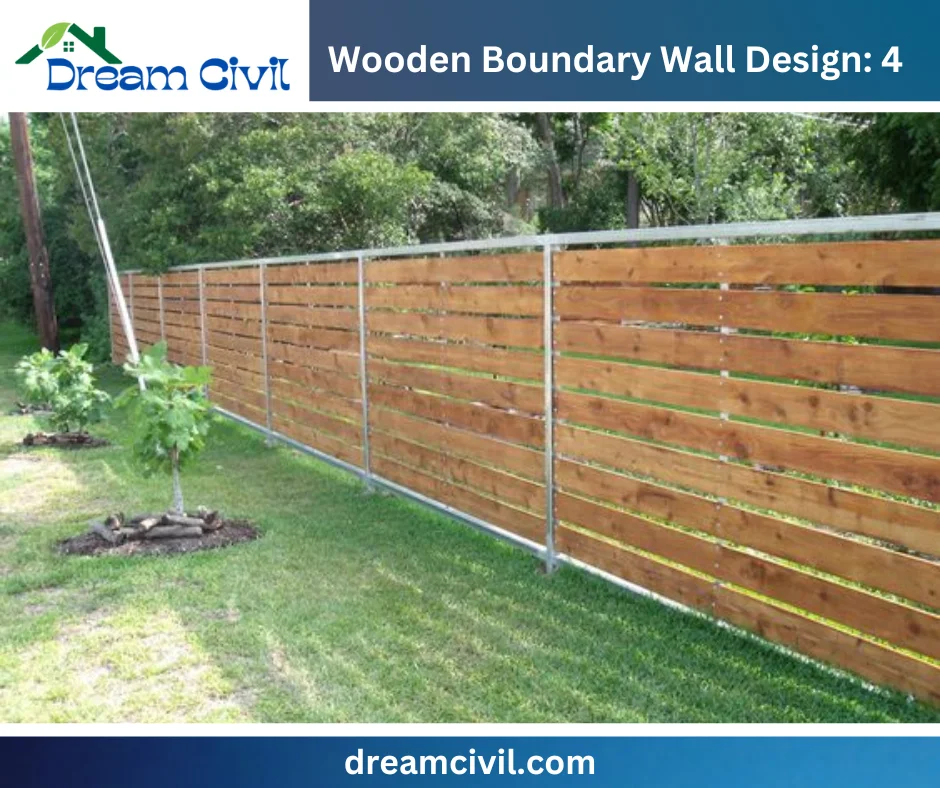
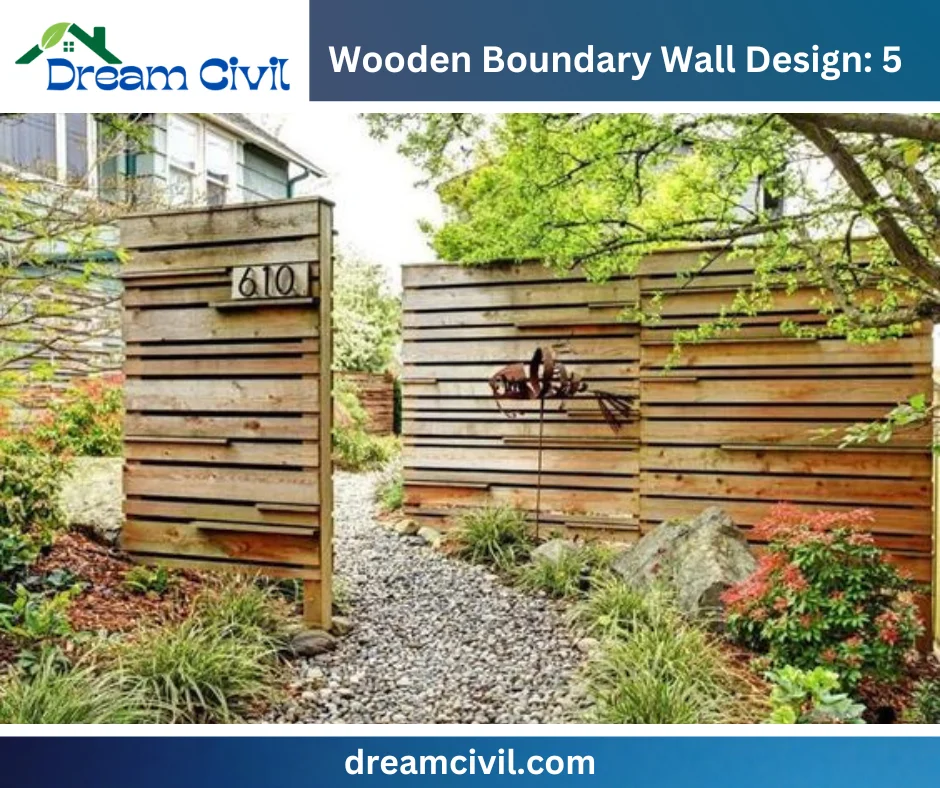
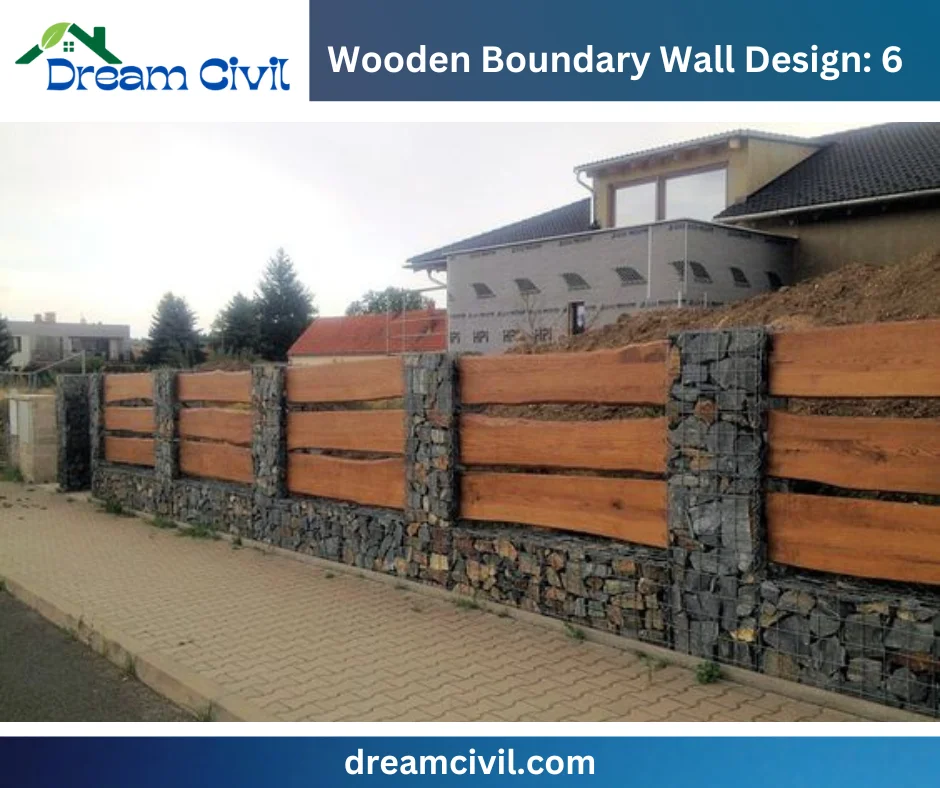
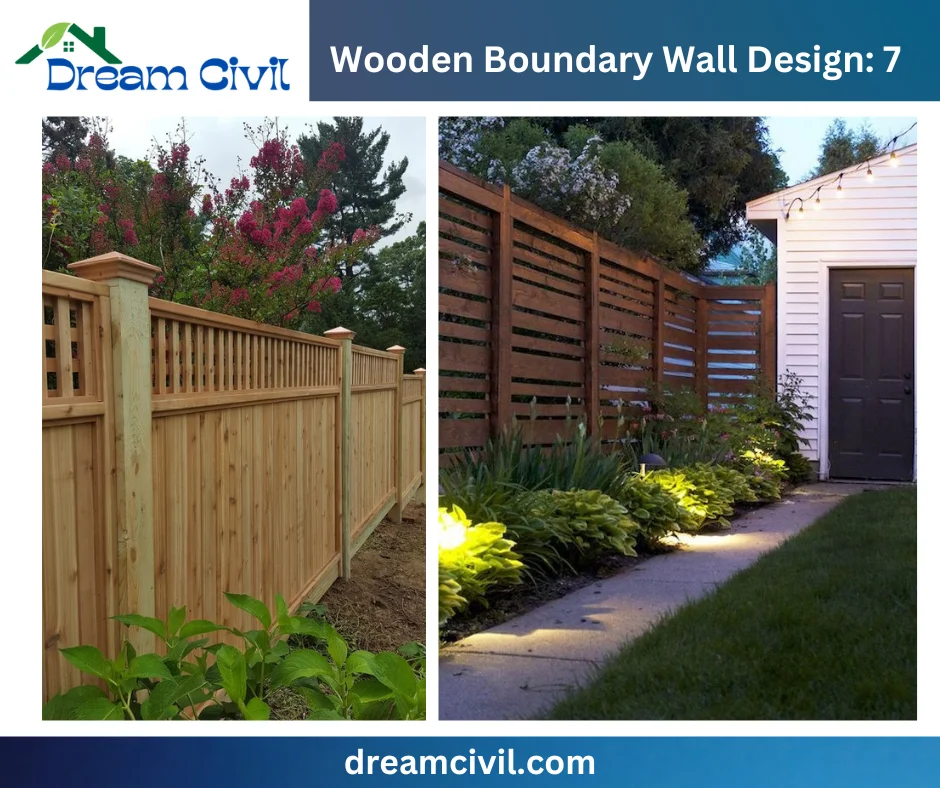
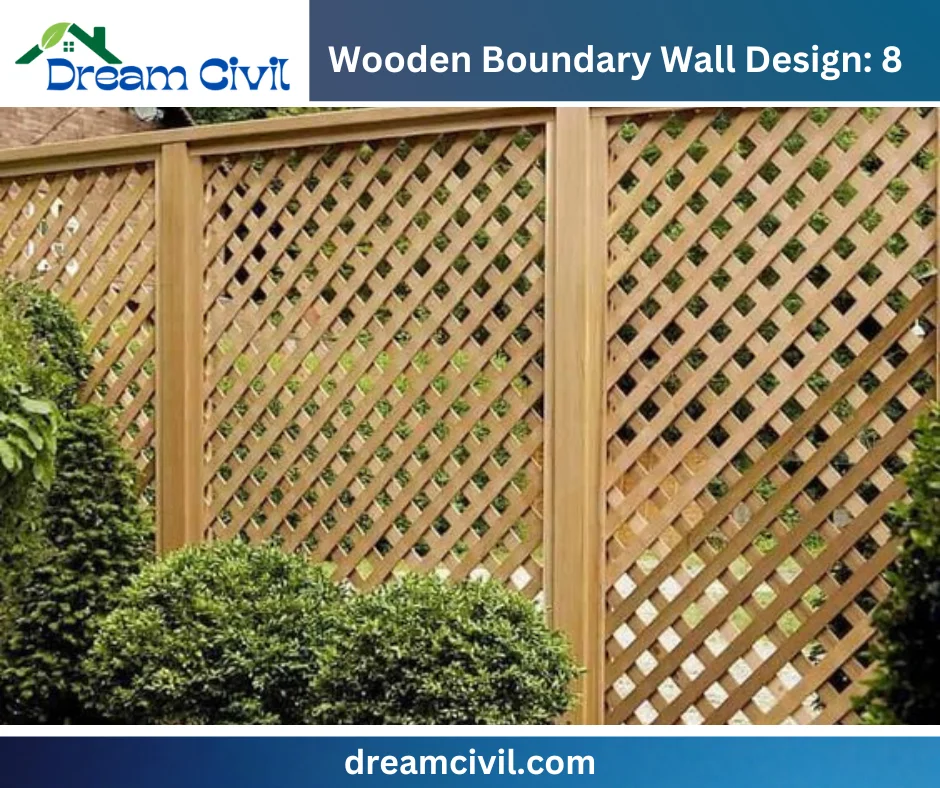
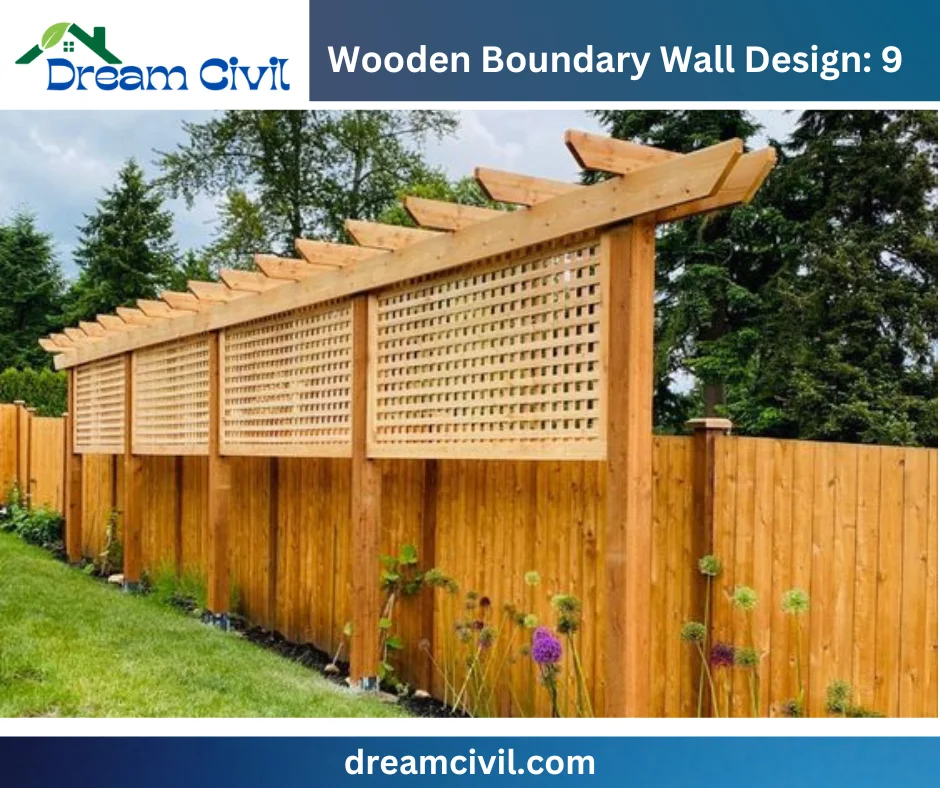
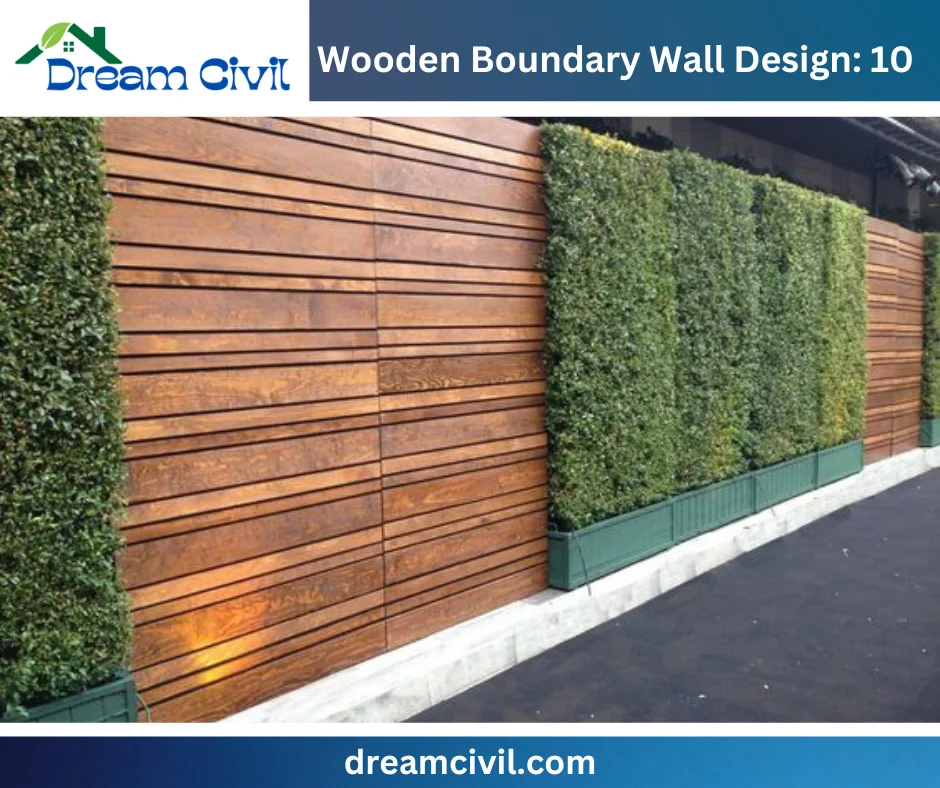
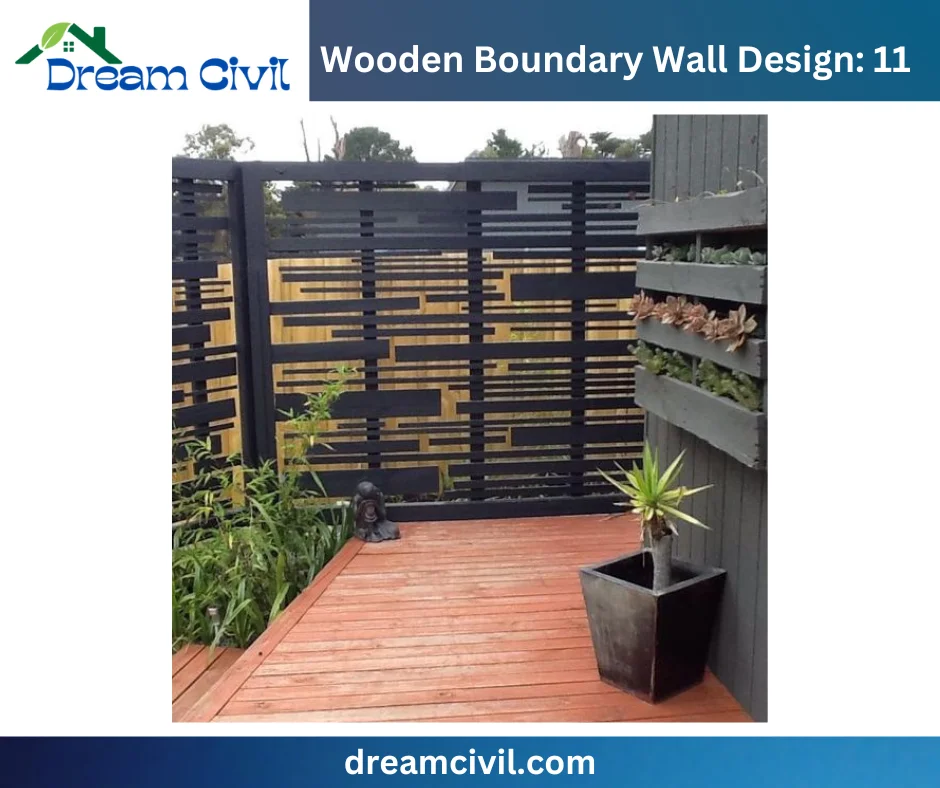

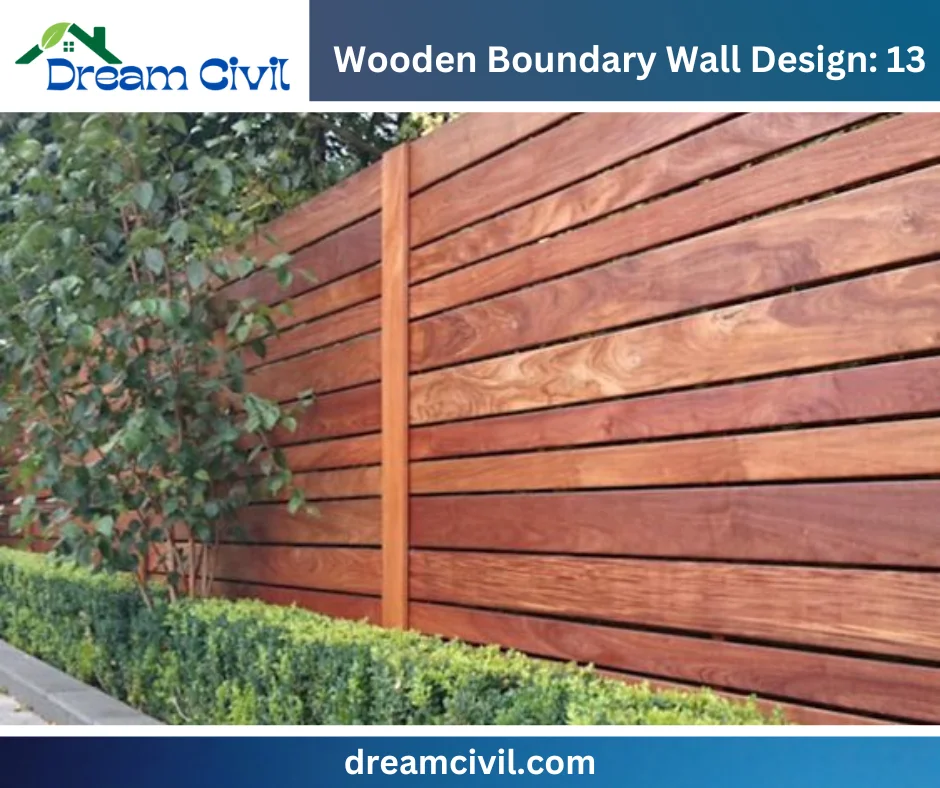
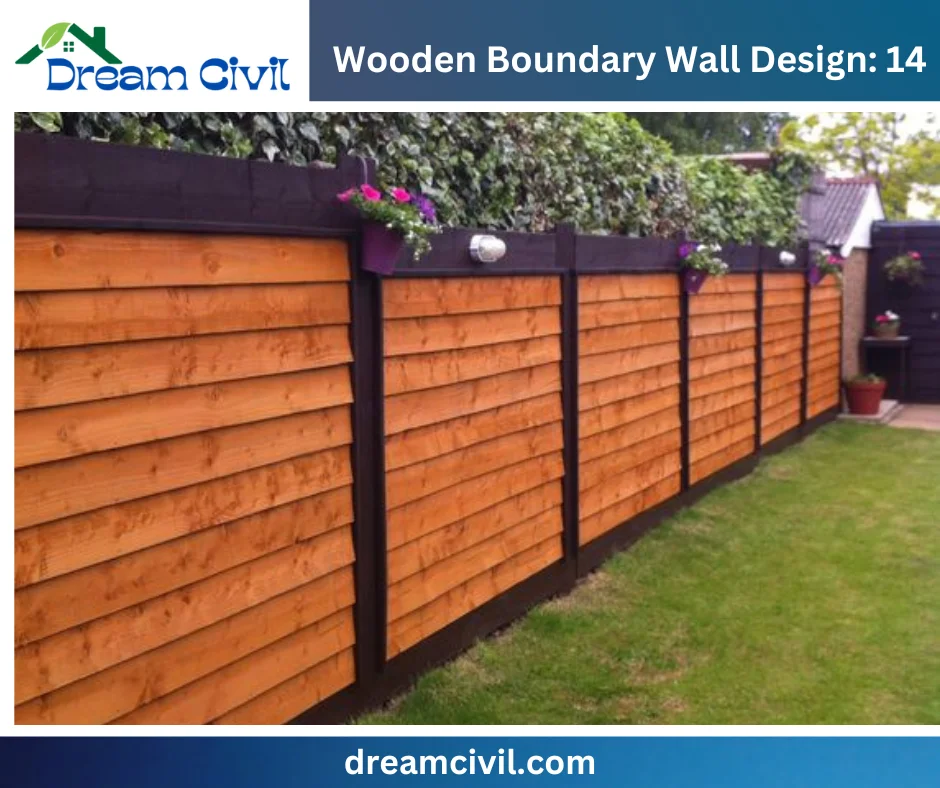
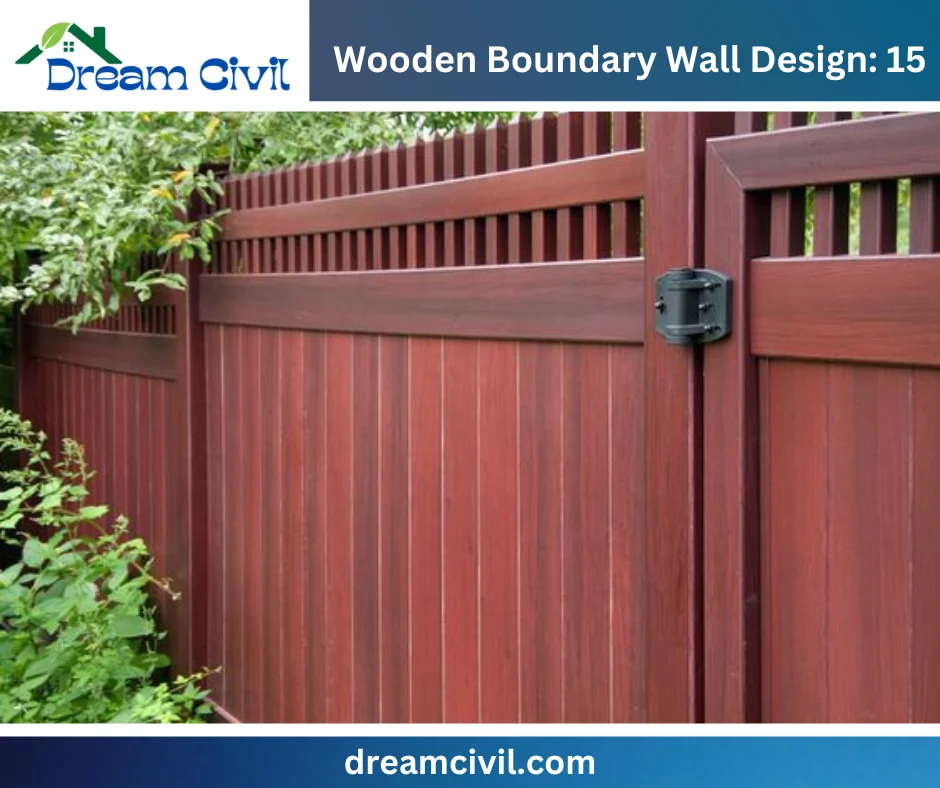
d. Steel/ Iron Boundary Wall
The boundary wall constructed using steel as the key material is called a steel boundary wall.
It is also referred to as the Iron Boundary Wall.
Most wire-fenced boundary walls are made up of steel, so we have included those inside the steel boundary walls.
Some of the information regarding the steel boundary wall is given below:
| Aspect | Description |
|---|---|
| Materials | Steel or iron, often with decorative elements. |
| Design & Style | Modern and industrial appearance; versatile design options. |
| Height & Width | Heights: 1.0-2.0 meters, Widths: 5-10 cm. |
| Privacy & Security | It provides some privacy and offers good security. |
| Durability | Highly durable and resistant to weathering. |
| Cost | Moderate to high price depending on design and materials. |
| Foundations | Requires solid foundations for stability. |
| Regulations | Must adhere to local building codes and standards. |
| Maintenance | Minimal maintenance; occasional rust prevention required. |
| Customization | Customizable with various ornamental features. |
Standard Height of Steel Boundary Wall
The standard height and width of steel boundary wall in different nations is provided below:
| Region | Typical Height | Typical Width |
|---|---|---|
| Asia | 1.0 – 2.0 meters (3 – 6.5 feet) | 5 – 10 centimeters (2 – 4 inches) |
| Europe | 1.0 – 2.0 meters (3 – 6.5 feet) | 5 – 10 centimeters (2 – 4 inches) |
| USA | 0.9 – 1.8 meters (3 – 6 feet) | 5 – 10 centimeters (2 – 4 inches) |
| Australia | 1.0 – 2.0 meters (3 – 6.5 feet) | 5 – 10 centimeters (2 – 4 inches) |
| India | 1.0 – 2.0 meters (3 – 6.5 feet) | 5 – 10 centimeters (2 – 4 inches) |
| UK | 1.0 – 2.0 meters (3 – 6.5 feet) | 5 – 10 centimeters (2 – 4 inches) |
| Canada | 1.0 – 2.0 meters (3 – 6.5 feet) | 5 – 10 centimeters (2 – 4 inches) |
| Philippines | 1.0 – 2.0 meters (3 – 6.5 feet) | 5 – 10 centimeters (2 – 4 inches) |
Stunning Designs of Steel Boundary Wall
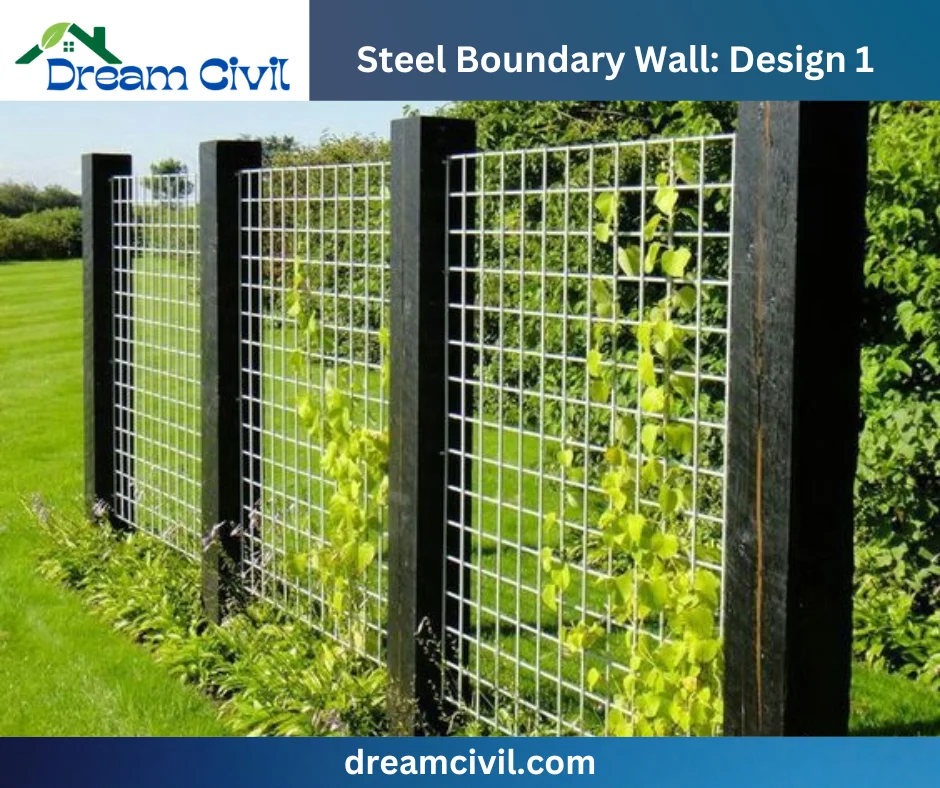

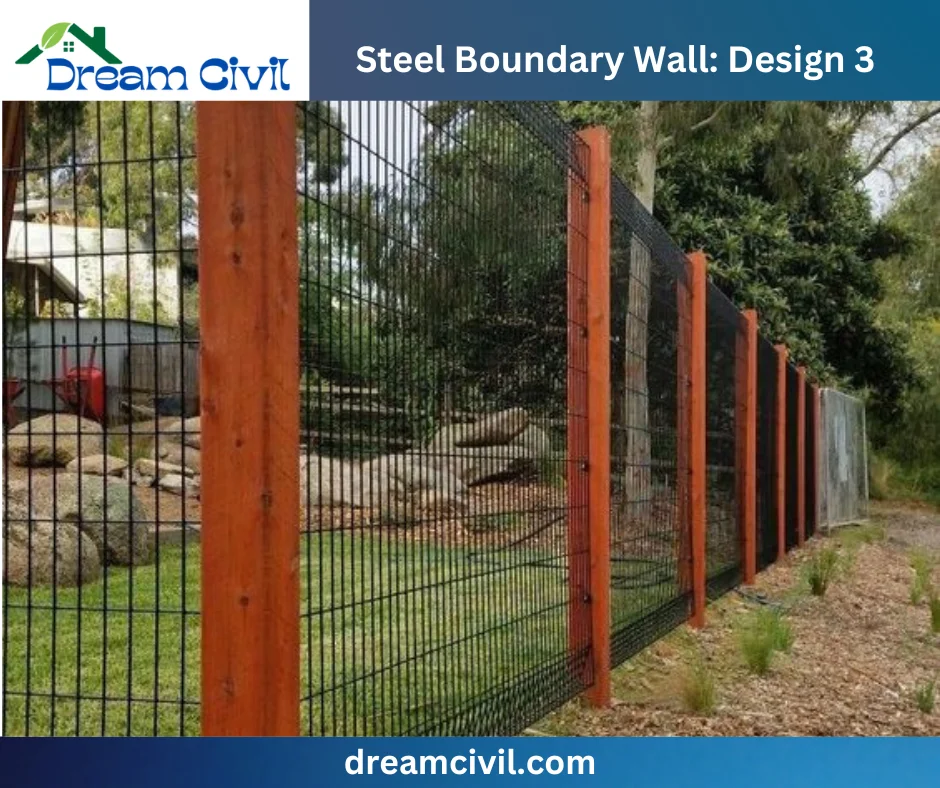
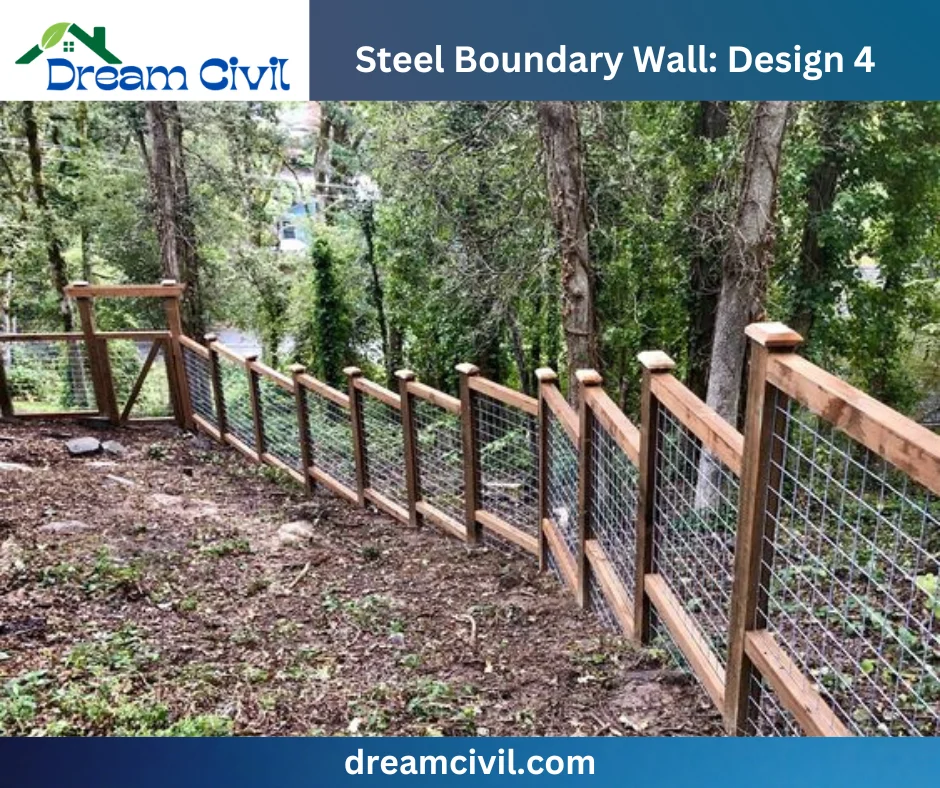
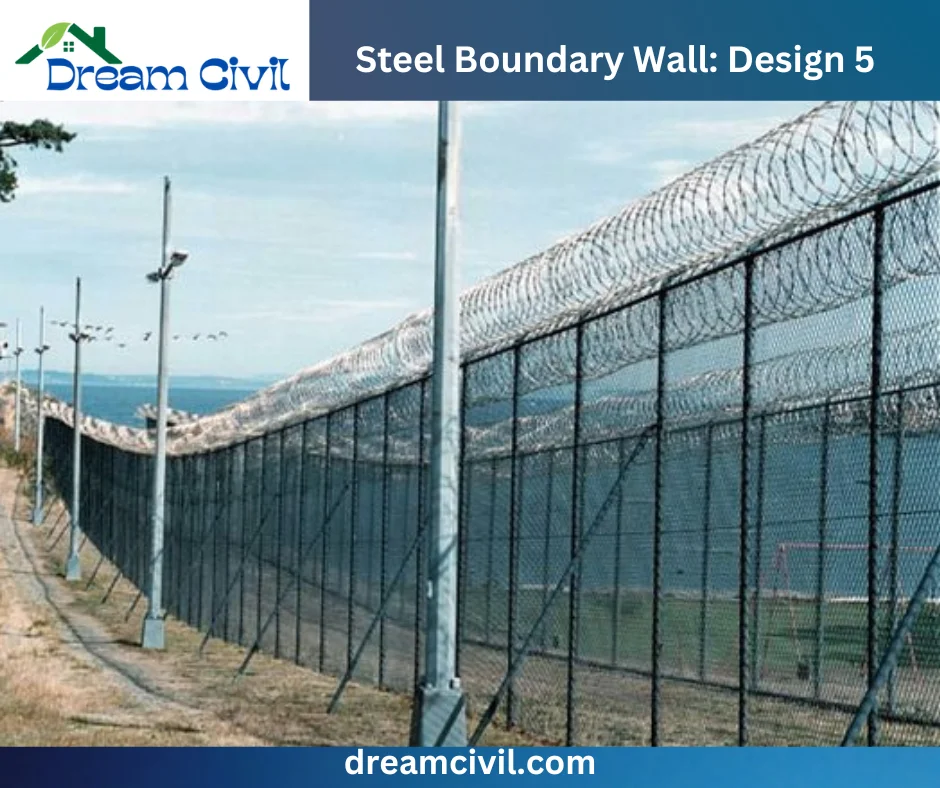
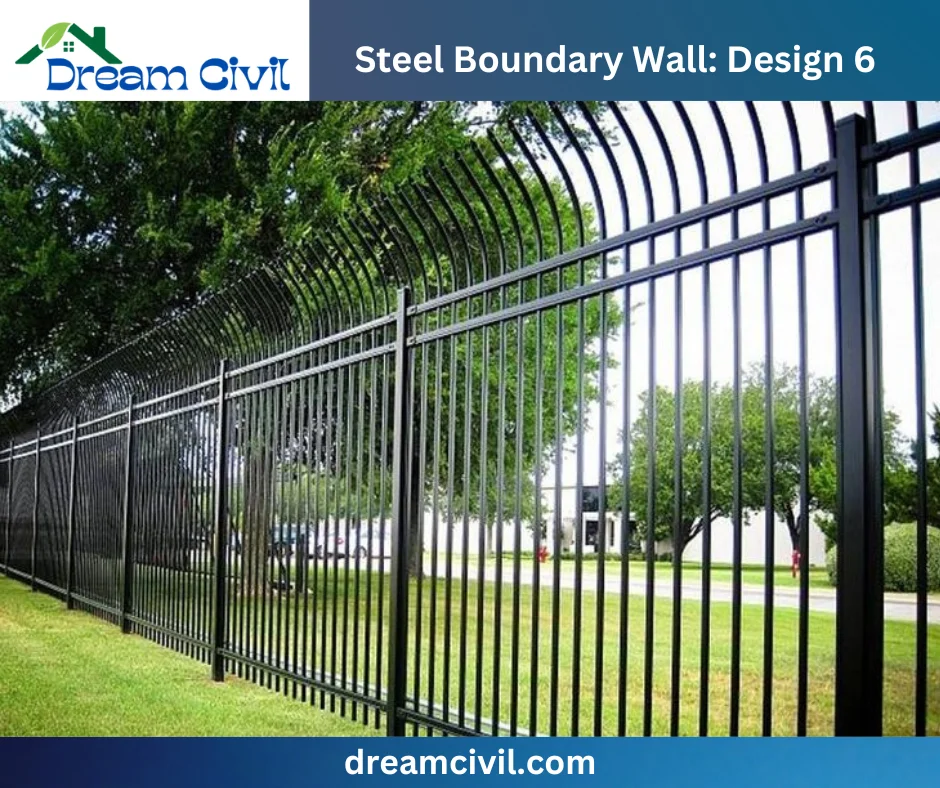
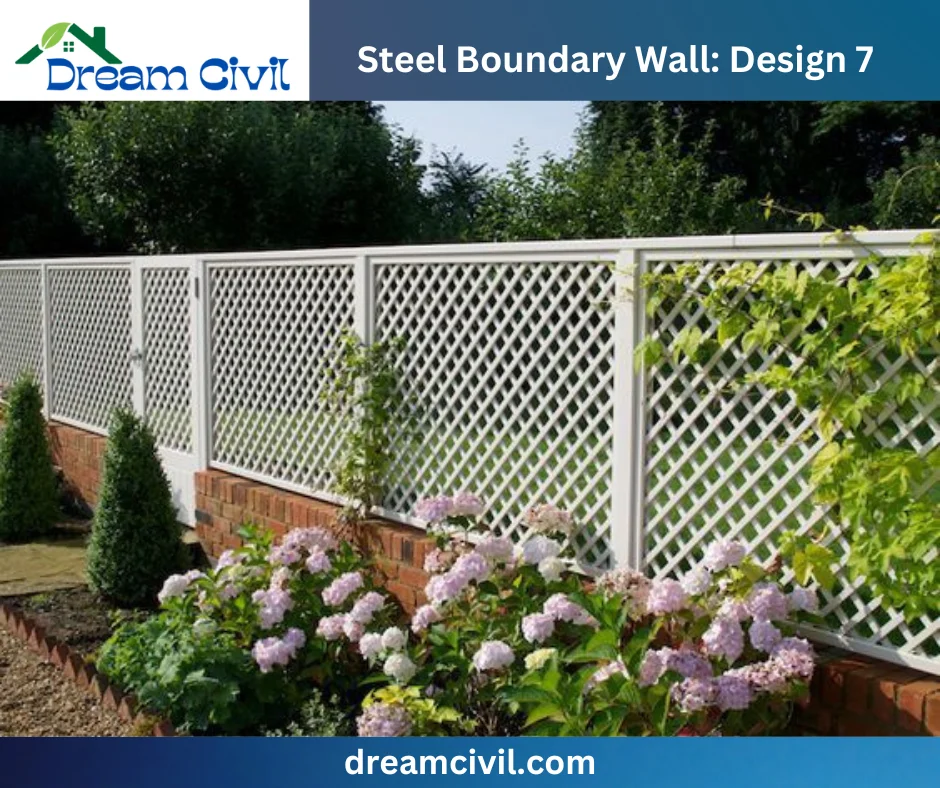
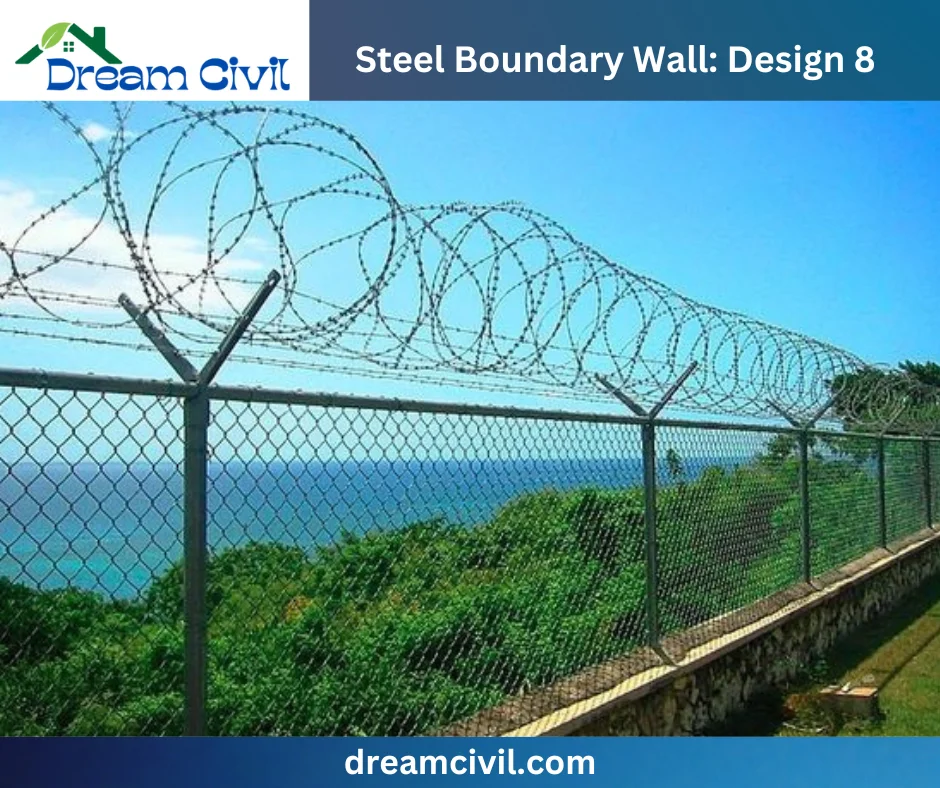
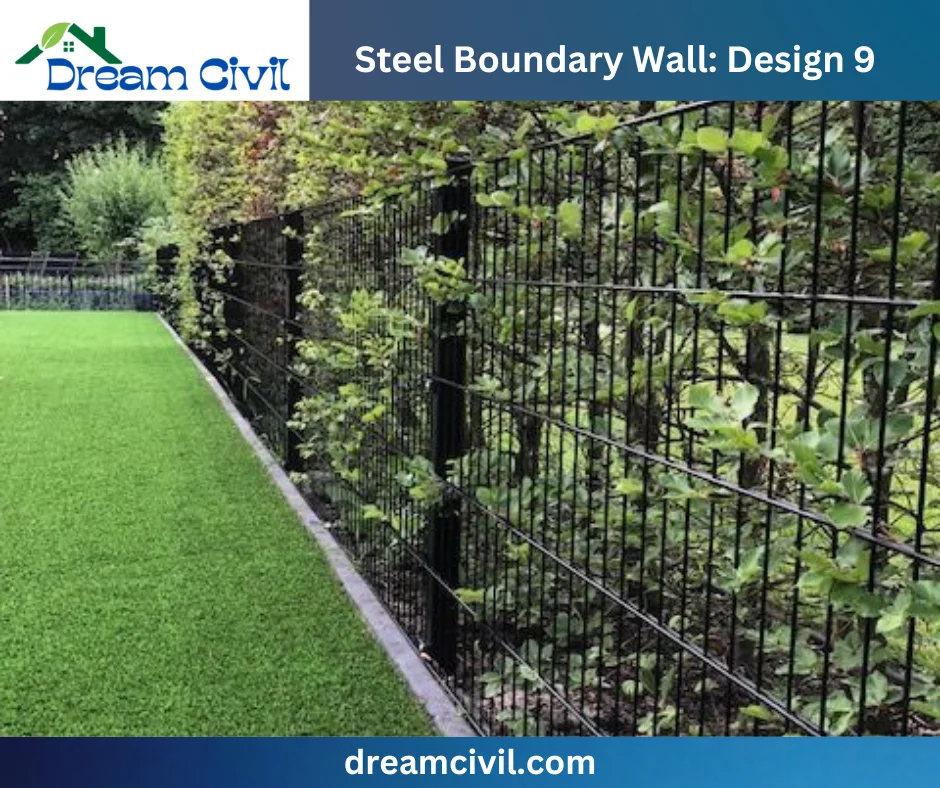
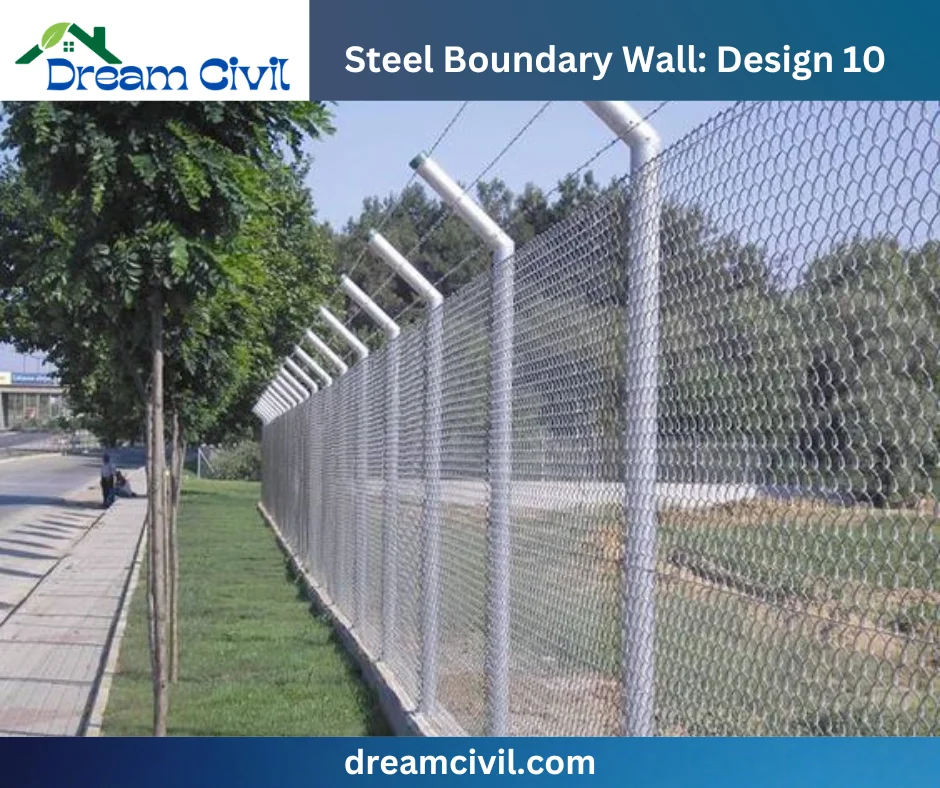
e. Concrete Boundary Wall
The boundary wall constructed using cast in situ concrete or precast concrete (like concrete blocks) as the chief material is called a concrete boundary wall.
Some of the information regarding the concrete boundary wall is given below:
| Aspect | Description |
|---|---|
| Materials | Concrete blocks or poured concrete. |
| Design & Style | Versatile design with options for textures and finishes. |
| Height & Width | Heights: 1.0-2.0 meters, Widths: 15-30 cm. |
| Privacy & Security | Offers privacy and security; suitable for various settings. |
| Durability | Extraordinarily durable and weather-resistant. |
| Cost | Moderate cost, with variations based on design complexity. |
| Foundations | Requires strong foundations for stability. |
| Regulations | Must adhere to local building codes and regulations. |
| Maintenance | Low maintenance; may need occasional repainting. |
| Customization | Customizable with textures, colors, and patterns. |
Standard Height of Concrete Boundary Wall
The standard height and width of concrete boundary wall in different nations is provided below:
| Region | Typical Height | Typical Width |
|---|---|---|
| Asia | 1.0 – 2.0 meters (3 – 6.5 feet) | 15 – 30 centimeters (6 – 12 inches) |
| Europe | 1.0 – 2.0 meters (3 – 6.5 feet) | 15 – 30 centimeters (6 – 12 inches) |
| USA | 0.9 – 1.8 meters (3 – 6 feet) | 15 – 30 centimeters (6 – 12 inches) |
| Australia | 1.0 – 2.0 meters (3 – 6.5 feet) | 15 – 30 centimeters (6 – 12 inches) |
| India | 1.0 – 2.0 meters (3 – 6.5 feet) | 15 – 30 centimeters (6 – 12 inches) |
| UK | 1.0 – 2.0 meters (3 – 6.5 feet) | 15 – 30 centimeters (6 – 12 inches) |
| Canada | 1.0 – 2.0 meters (3 – 6.5 feet) | 15 – 30 centimeters (6 – 12 inches) |
| Philippines | 1.0 – 2.0 meters (3 – 6.5 feet) | 15 – 30 centimeters (6 – 12 inches) |
Stunning Designs of Concrete Boundary Wall
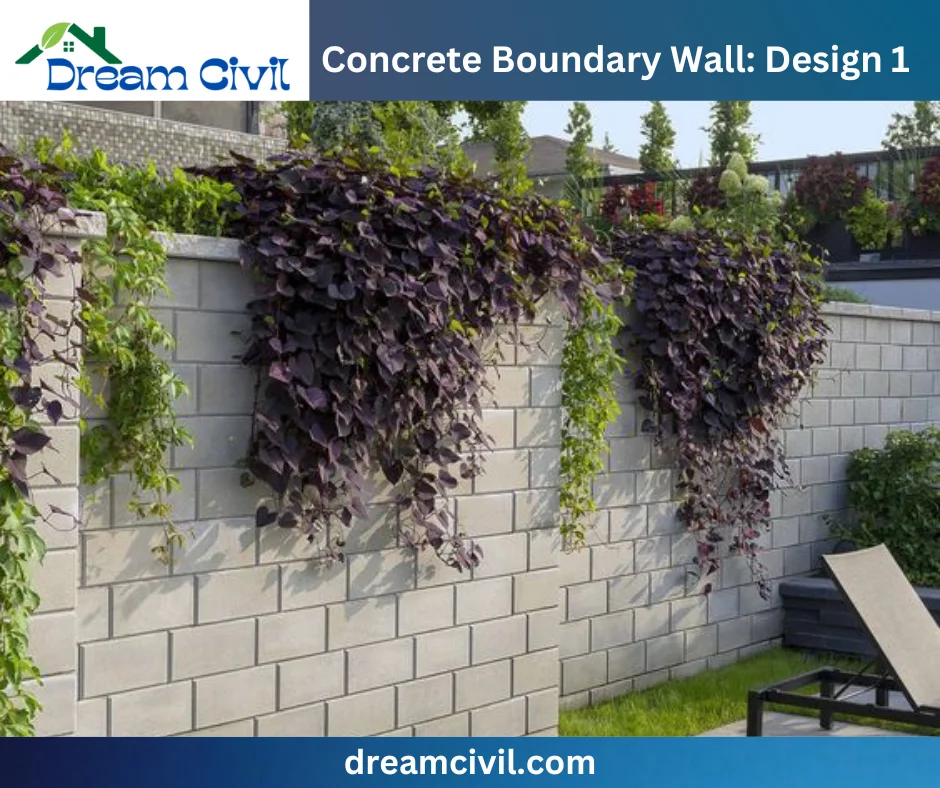
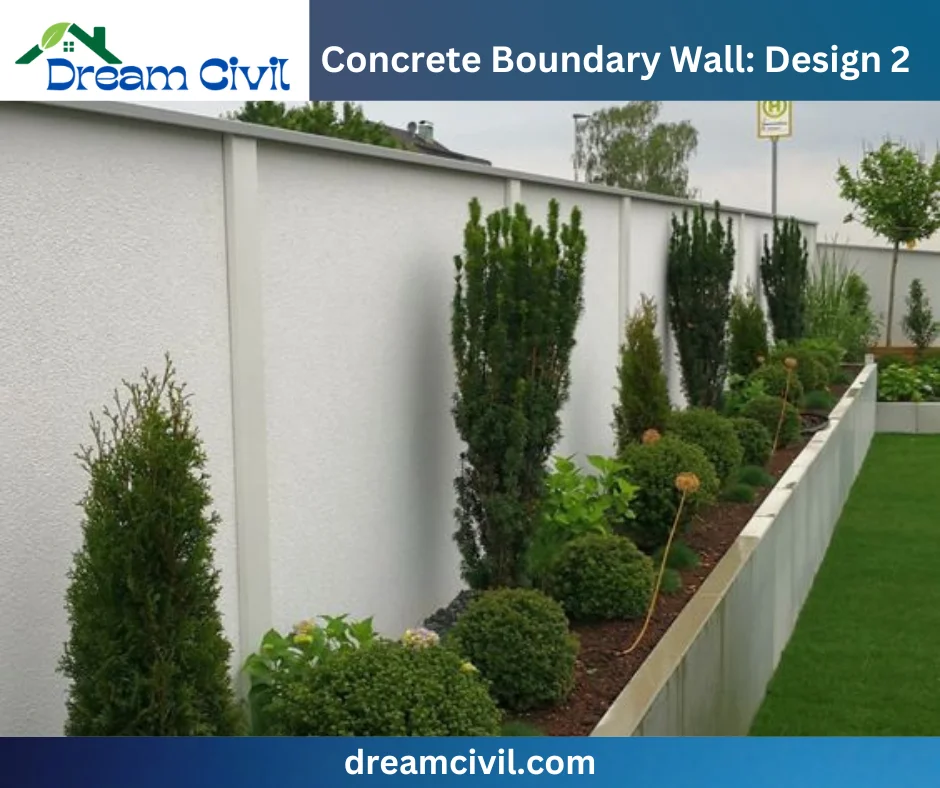
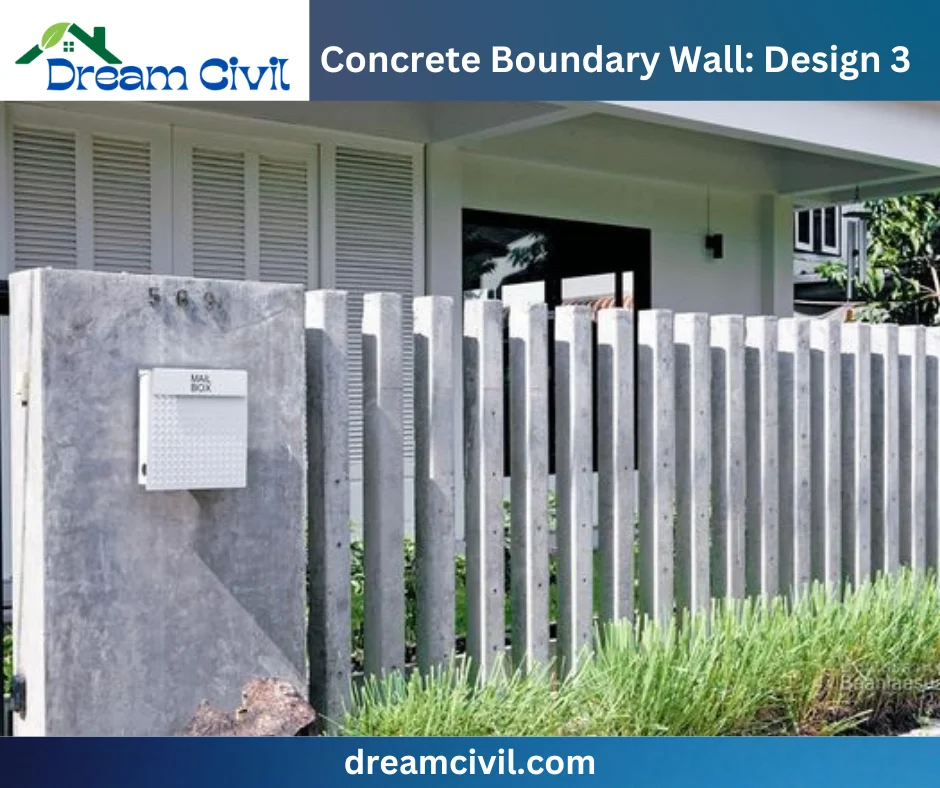


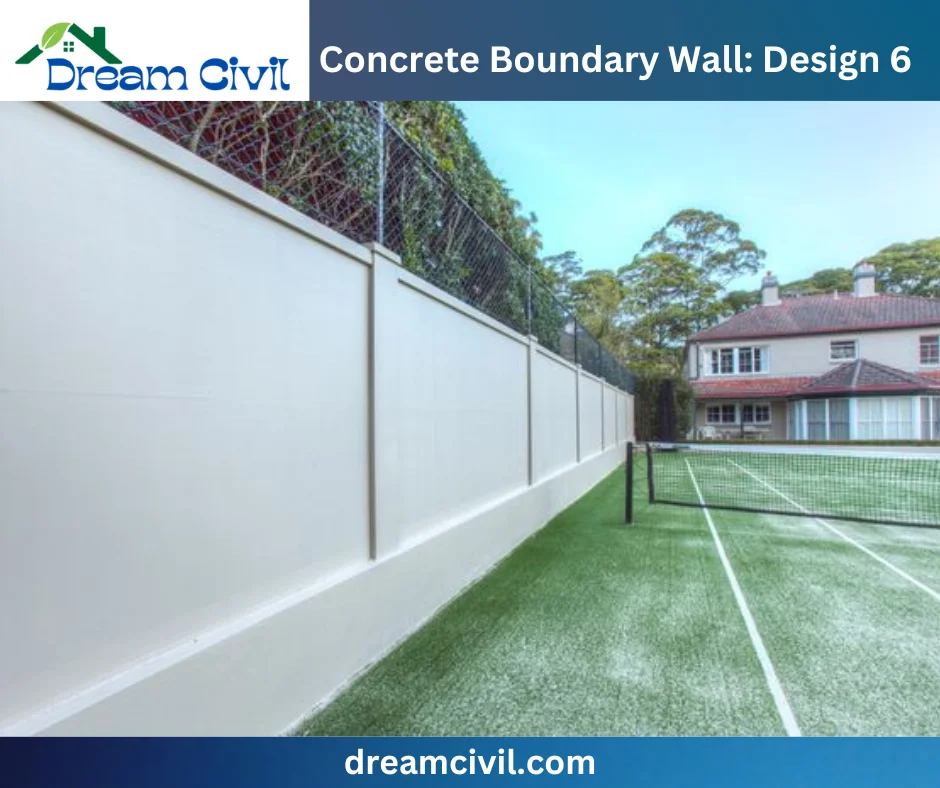
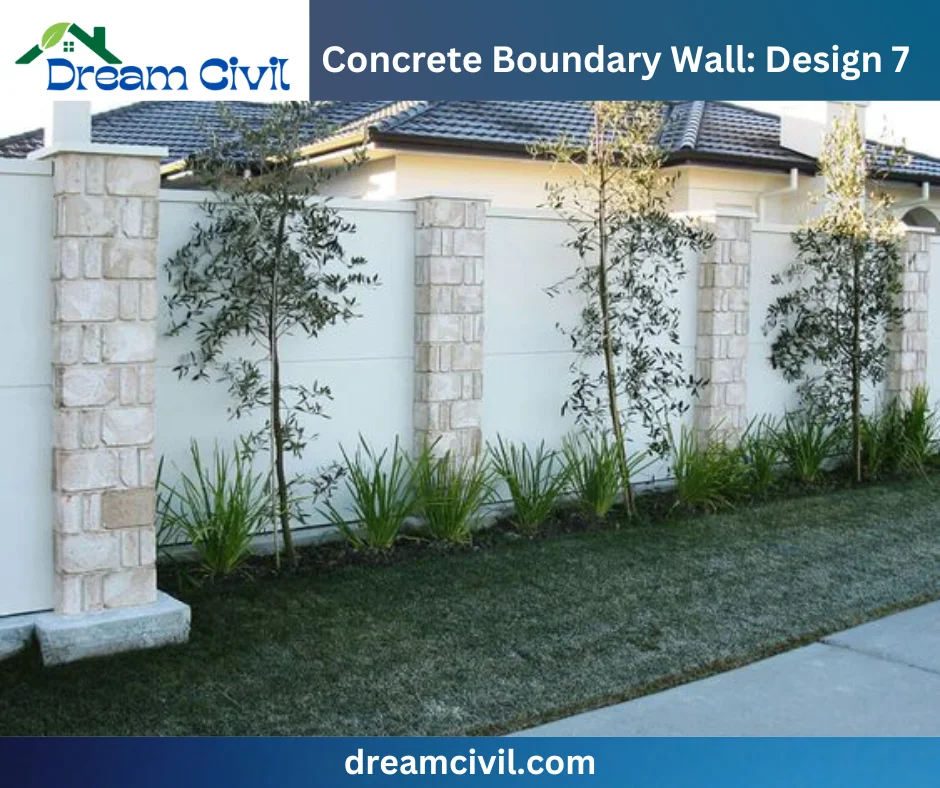
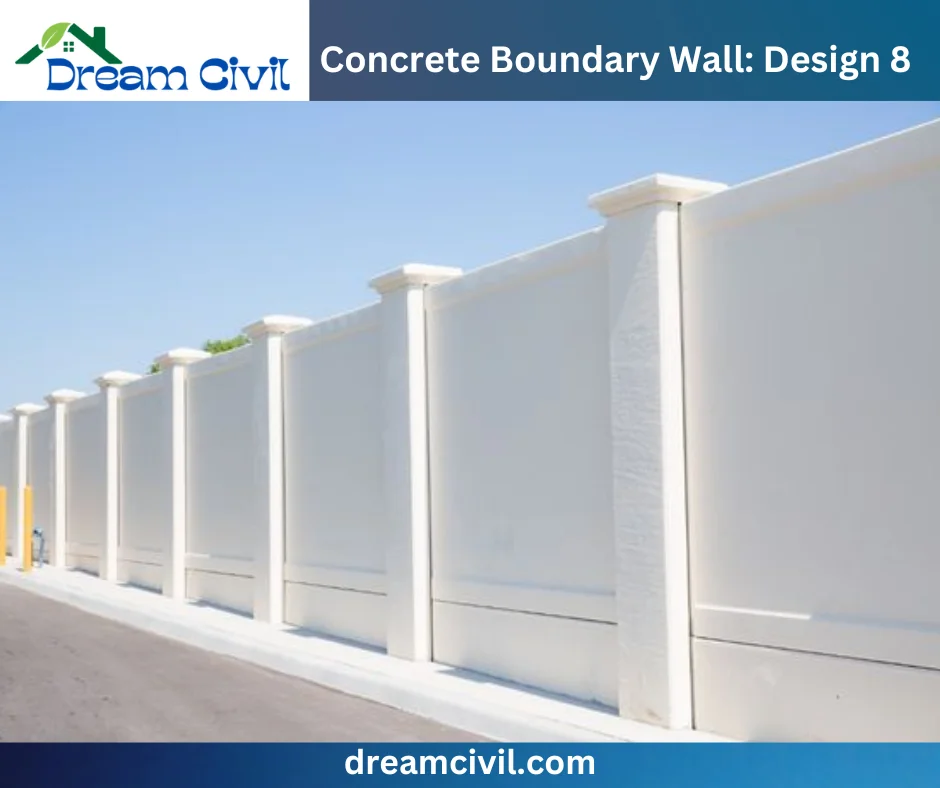
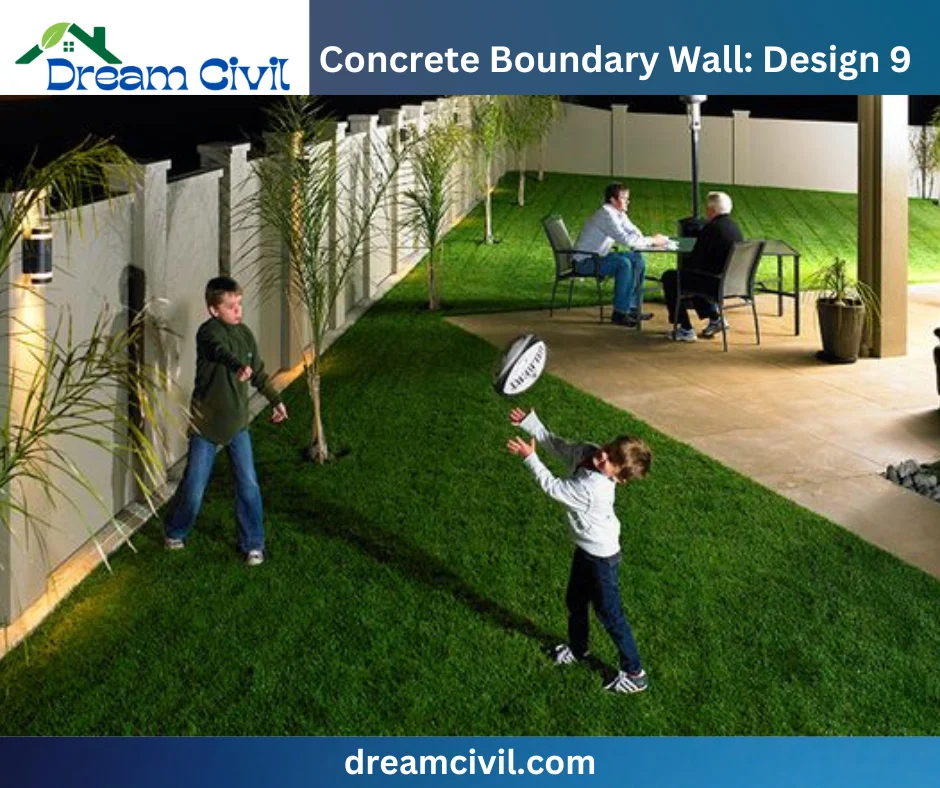
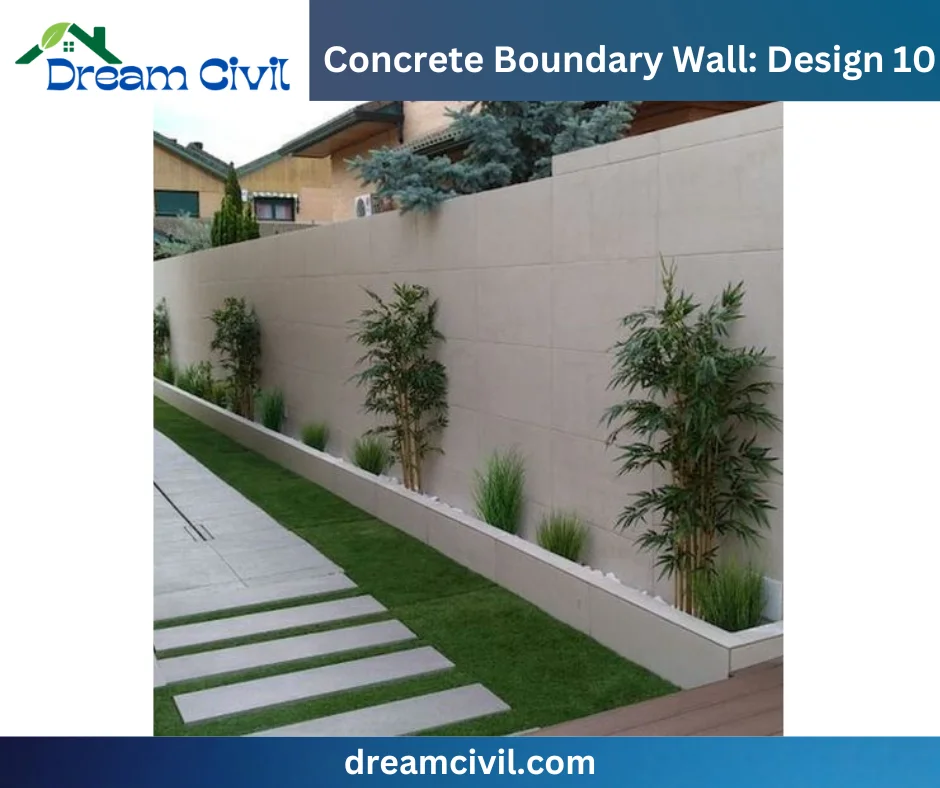
g. Living Boundary Wall (Hedge or Vegetation or Plant)
The boundary wall where plants or vegetation are utilized is called a plant boundary wall.
Some of the information regarding the plant boundary wall is given below:
| Aspect | Description |
|---|---|
| Materials | Live plants or hedges, such as shrubs or trees. |
| Design & Style | Natural and green, with variations in plant types. |
| Height & Width | Heights: 1.0-2.5 meters (varies by plant type), Widths: Varies based on plant type. |
| Privacy & Security | It provides privacy but may be less secure than other materials. |
| Durability | Subject to plant health and maintenance, it may require regular pruning. |
| Cost | Costs vary based on plant selection and maintenance needs. |
| Foundations | No structural foundation; relies on plant root systems. |
| Regulations | We may need to adhere to local regulations regarding plant heights and maintenance. |
| Maintenance | Regular pruning and care to maintain shape and health. |
| Customization | Limited customization in terms of plant types and growth patterns. |
Standard Height of Plant Boundary Wall
The standard height and width of plant boundary wall in different nations is provided below:
| Region | Typical Height | Typical Width |
|---|---|---|
| Asia | 1.0 – 2.5 m (3′ – 8′) | Varies based on plant type |
| Europe | 0.8 – 2.0 m(2.5′ – 6.5′) | Varies based on plant type |
| USA | 1.0 – 2.5 m(3′ – 8′) | Varies based on plant type |
| Australia | 1.0 – 2.5 m(3′- 8′) | Varies based on plant type |
| India | 1.0 – 2.5 m (3′ – 8′) | Varies based on plant type |
| UK | 0.8 – 2.0 m(2.5′ – 6.5′) | Varies based on plant type |
| Canada | 0.8 – 2.0 m(2.5′ – 6.5′) | Varies based on plant type |
| Philippines | 1.0 – 2.5 m (3′ – 8′) | Varies based on plant type |
Stunning Designs of Plant Boundary Wall

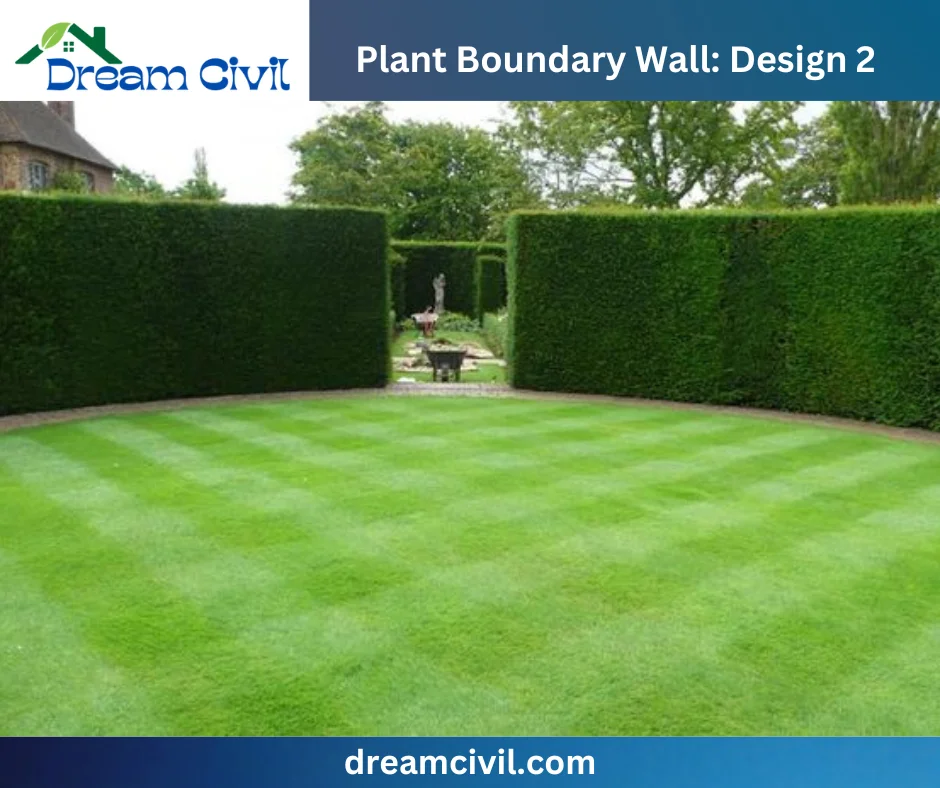
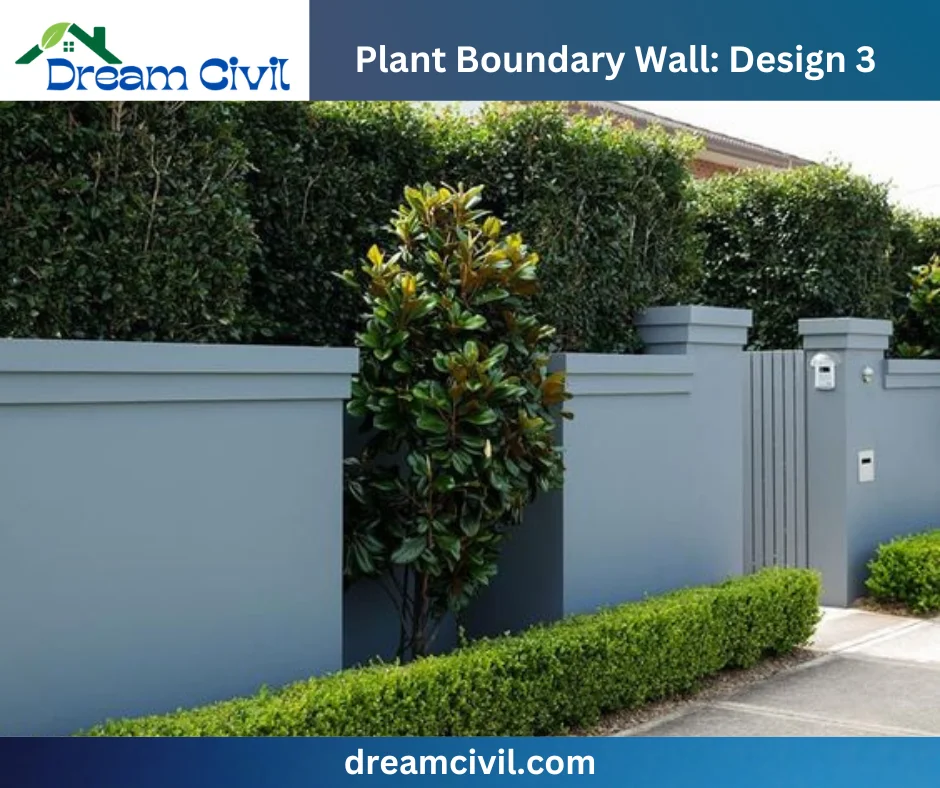
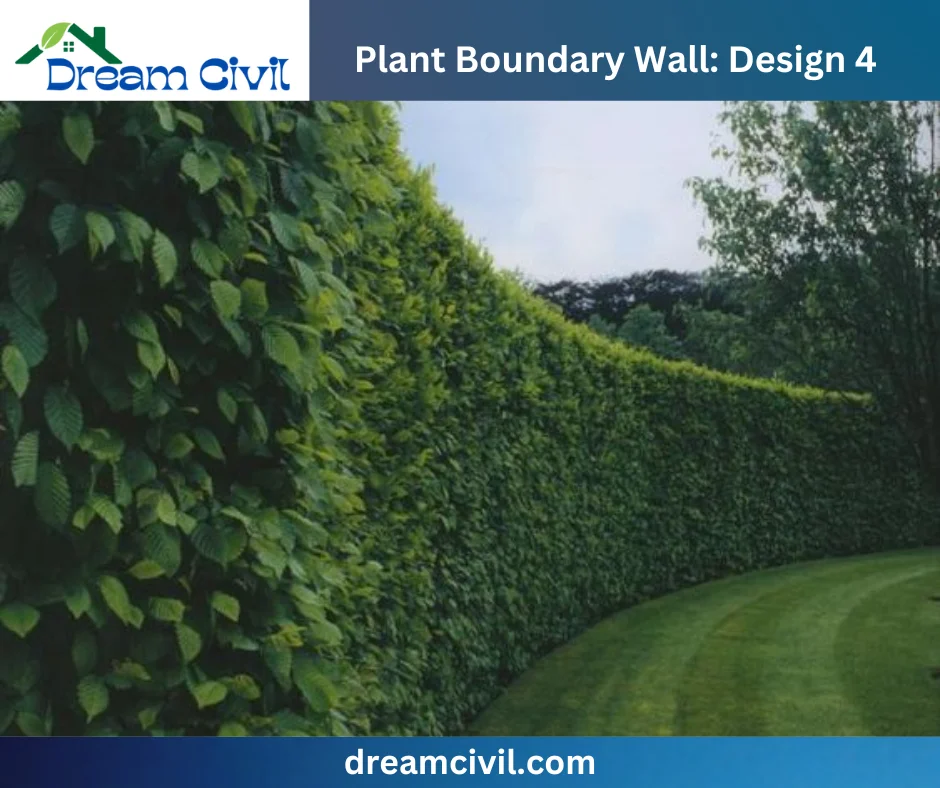

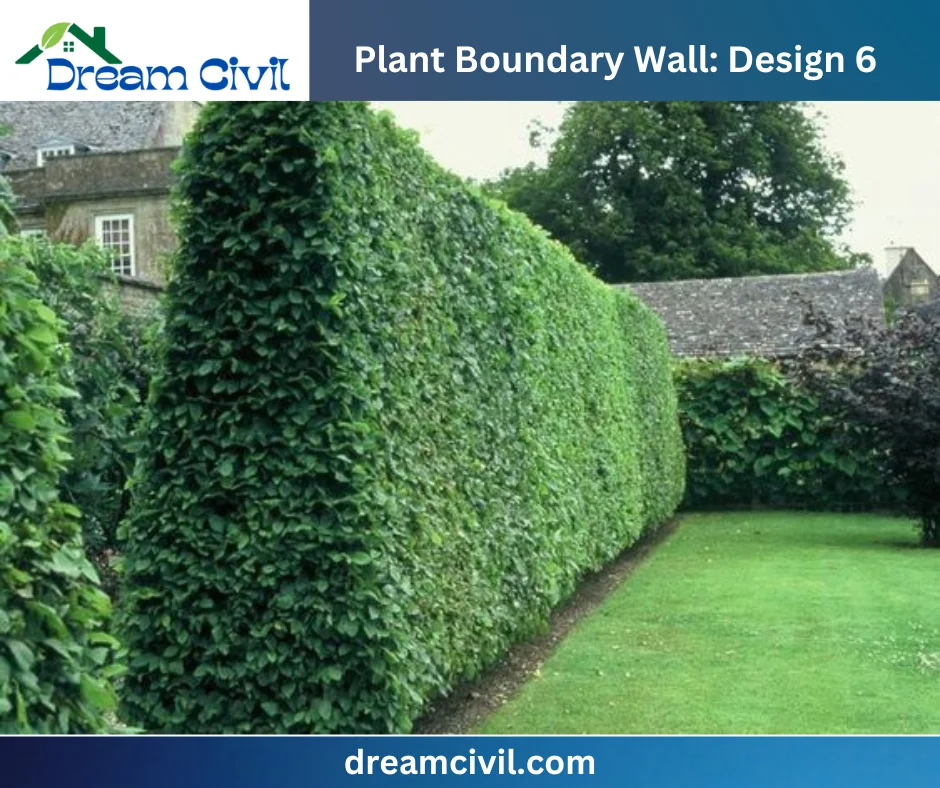

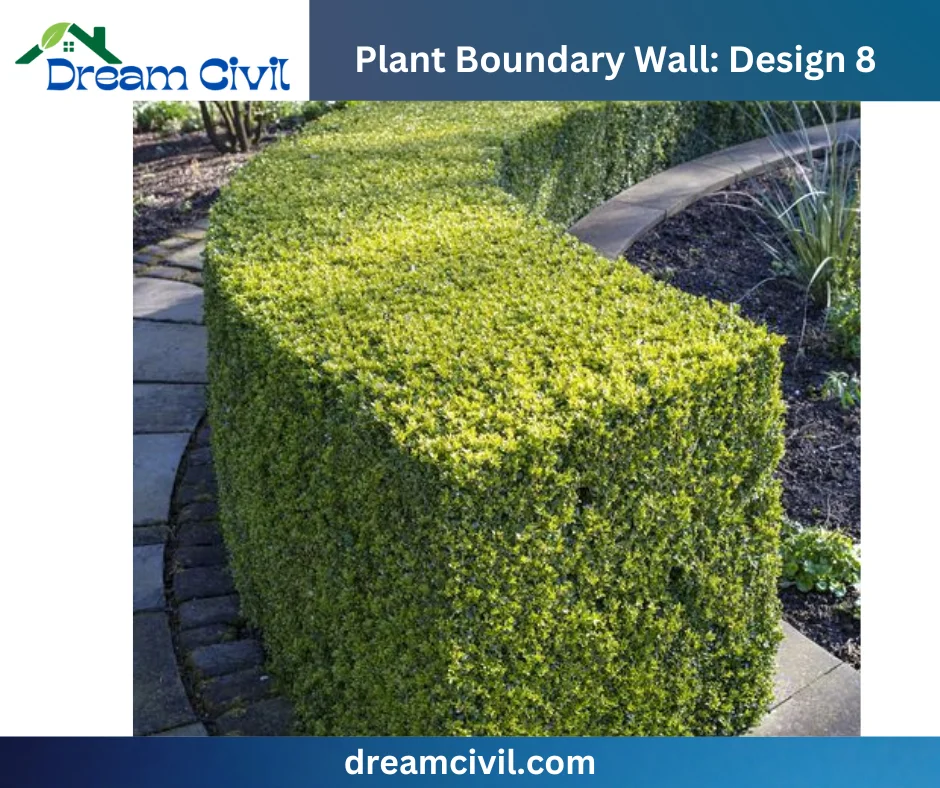
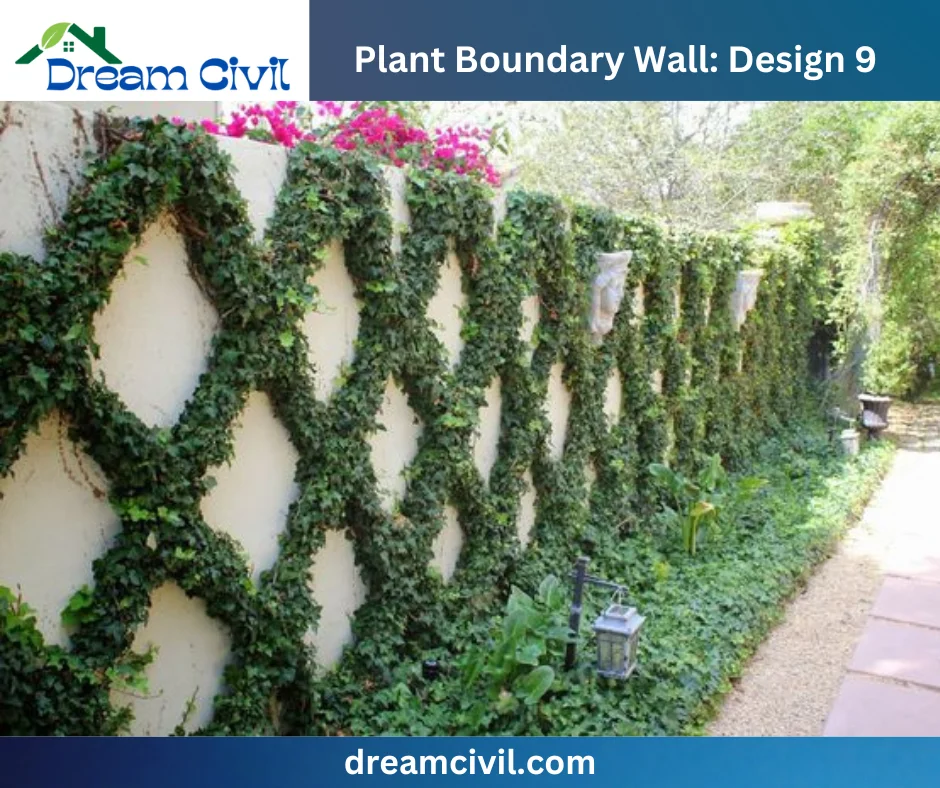
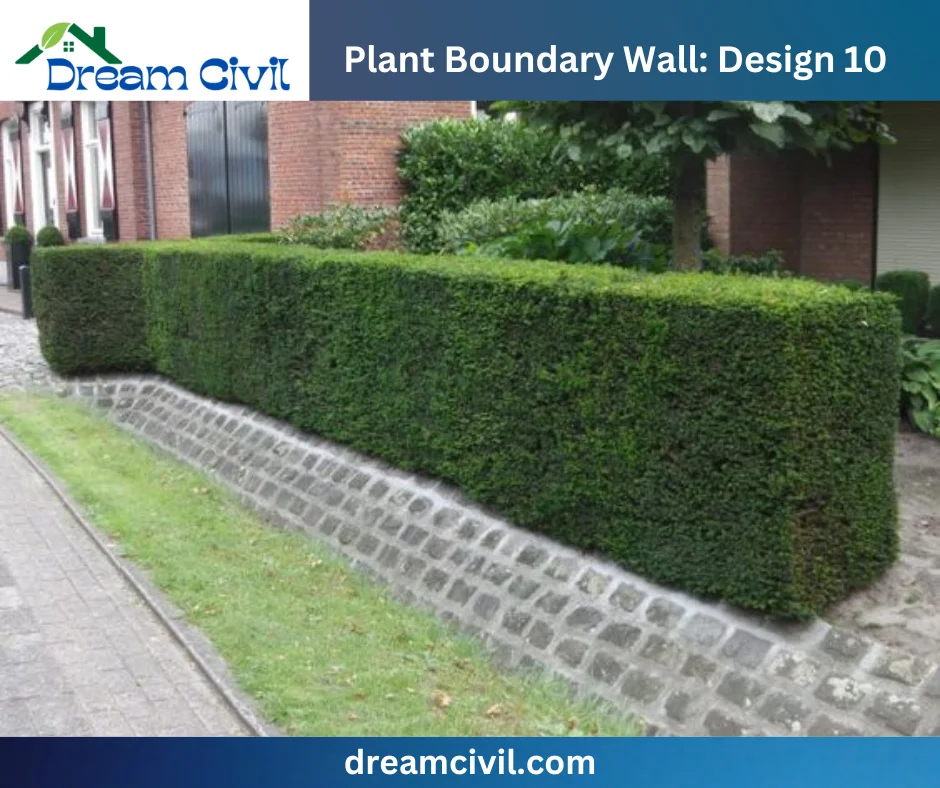
4. Advantages of Boundary Wall
a. It improves the aesthetic look.
b. It provides privacy, safety, and security to the structure.
c. It reduces the conflict between the landlords.
5. Disadvantages of Boundary Wall
a. Chance of overturning if the low depth is provided below ground level.
b. High initial construction cost.
c. Requirements of maintenance.
| Read Also: Parapet Wall |
| Verified Article By Er. Madhu Krishna Poudel |

